France June 2016 - Versailles
|
|
We drove from Fontainebleu to Versailles which was only an hour or so drive. Versailles is roughly 12 miles southwest of Paris center.
Versailles: the big one. The Grandaddy. The most fabulous palace ever built. If you've read the blog on this entire trip in order, you've probably noticed we started with the earliest catle "Keeps" and have seen them get larger and larger, moving from castles designed to withstand attacks and sieges to larger and more impressive chateaus and palaces designed for beauty and to impress visiting dignitaries. Versaille is the culmination of this effort. Per Rick Steves: "Europe's next-best palaces are just Versailles wannabes."
Versailles was "the world's most celebrated chateau, an emblem of both the ancien regime and French regal indulgence. More than twenty thousand nobles, courtiers, merchants, and servants eventually basked in the radiance of the Sun King and his dimmer heirs, crowding together in what one traveler described as a "a state of unhygienic squalor." - Rick Atkinson, "The Guns at Last Light".
Versailles is a huge tourist attraction and has a big parking lot out front designed for tour buses. The Palace of Versailles received 7,700,000 visitors in 2017, making it the second-most visited monument in France, just behind the Louvre and ahead of the Eiffel Tower. There are many ticket options and it can be confusing. The Rick Steves book offers some strategies for avoiding the crowds and ticket lines.
I could not find a B&B in the town of Versailles so I made reservations in a small hotel called the Hotel Le Cheval Rouge (built in 1676 as Louis XIV's stables). It was within walking distance of the Palace and had parking for the car which was key. So it worked out great. We checked into the hotel, then walked to the Palace.
|
| |
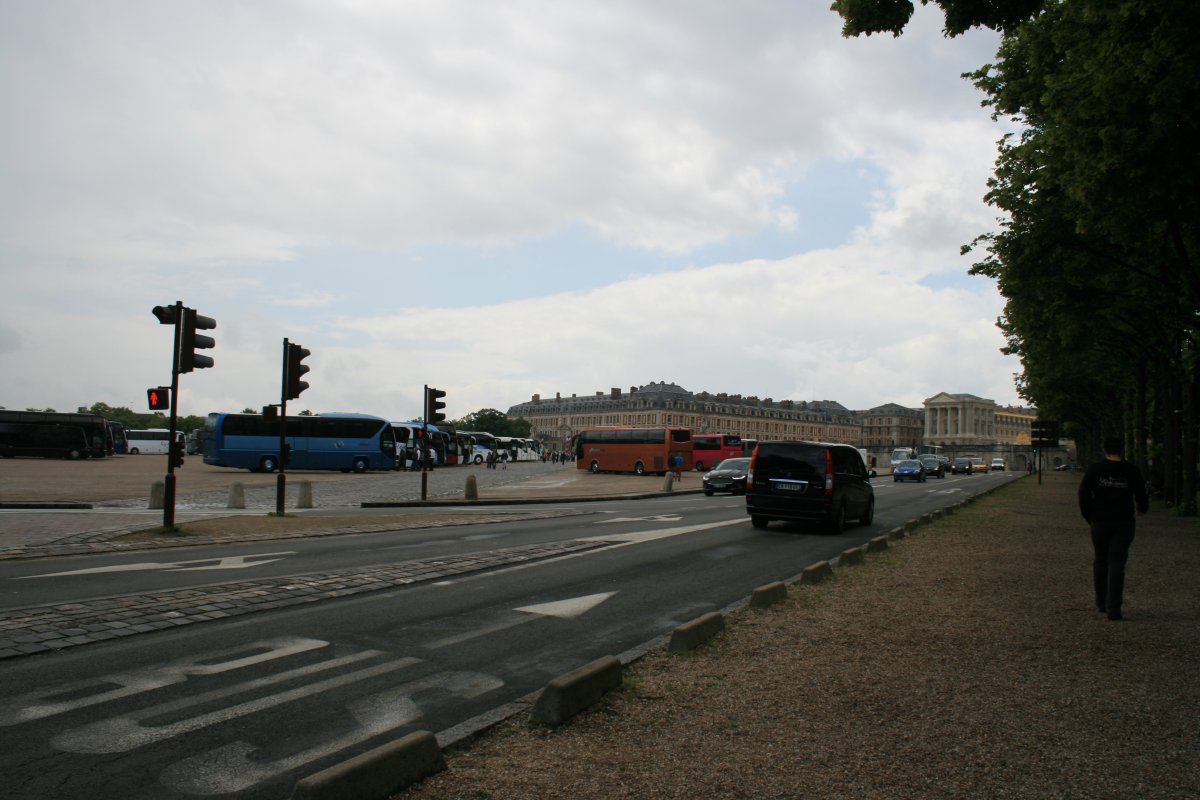 |
|
|
Entire books have been written on the Palace of Versailles so I will just give you the bare outline. Versailles was the principal royal residence of France from 1682, under Louis XIV, until the start of the French Revolution in 1789, under Louis XVI.
Versailles was first a small village and church, surrounded by forests filled with abundant game. After he became King in 1610, Louis XIII bought some land here, and in 1623-24 built a modest two-story hunting lodge on the site of the current marble courtyard. In 1631-1634, Louis XIII decided to make his hunting lodge into a château. He purchased the surrounding land and had architect Philibert Le Roy replace the hunting lodge with a château of brick and stone, along with the addition of gardens and a park.
Louis XIV first visited the château on a hunting trip in 1651 at the age of twelve. In 1661 he suddenly acquired a passion for the site. He decided to rebuild, embellish and enlarge the château and to transform it into a setting for both rest and for elaborate entertainments on a grand scale. The first phase of the expansion (1661–1678) was designed and supervised by the architect Louis Le Vau. The king also commissioned the landscape designer André Le Nôtre to create the most magnificent gardens in Europe, embellished with fountains, statues, basins, canals, geometric flower beds and groves of trees. [As you recall, both Louis Le Vau and Andre Le Notre had designed Vaux for Fouquet]
The palace was enlarged under both Louis XV and Louis XVI.
In 1783, the Palace was the site of the signing of three treaties of the Peace of Paris (1783), in which the United Kingdom recognized the independence of the United States.
The King Louis XVI and Queen Marie Antoinette learned of the storming of the Bastille in Paris on July 14, 1789 while they were at the Palace, and remained isolated here as the Revolution in Paris spread. The growing anger in Paris led to the Women's March on Versailles on 5 October 1789. A crowd of several thousand men and women, protesting the high price and scarcity of bread, marched from the markets of Paris to Versailles. They took weapons from the city armory, besieged the Palace, and compelled the King and Royal family and the members of the National Assembly to return with them to Paris the following day. As soon as the royal family departed, the Palace was closed, awaiting their return—but in fact, the monarchy would never again return to Versailles.
The new revolutionary government ordered the transfer of all the paintings and sculptures from the Palace to the Louvre. In 1793, the Convention declared the abolition of the monarchy, and ordered all of the royal property in the Palace to be sold at auction. All fleurs-de-lys and royal emblems on the buildings were chambered or chiseled off. The empty buildings were turned into a storehouse for furnishings, art and libraries confiscated from the nobility.
Napoleon Bonaparte considered making Versailles his residence, but abandoned the idea because of the cost of the renovation.
"The palace had served as a headquarters for the Prussian army besieging Paris in the starving winter of 1870, when 65,000 Parisians perished despite eating the city's cats, crows, and rats. Here , in January 1871, the German Empire had been proclaimed in the Hall of Mirrors, that exquisite gallery of seventeen reflecting arches facing seenteen arcaded windows. Here too, with a grim and vengeful echo, the treaty to end the First World War was signed in June 1919, as celebratory guns boomed, fountains spurted, and blue-coated Republican Guardsmen held their sabers aloft to salute the Hun's subjugation. Two decades later the Hun was back, for a four-year stay." - Rick Atkinson
In 1944 Eisenhower located his Supreme Headquarters Allied Expeditionary Force (SHAEF) at the plush Trianon Palace Hotel (now a Waldorf Astoria) in Versailles.
The end of the 19th and the early 20th century saw the beginning of restoration efforts at the Palace. Between 1925 and 1928, the American philanthropist and multi-millionaire John D. Rockefeller gave $2,166,000, the equivalent of about thirty million dollars today, to restore and refurnish the palace. The conservation and restoration was interrupted by two world wars, but has continued until the present day.
That gold gate is a replica of the original and is decorated with 100,000 gold leaves.
|
| |
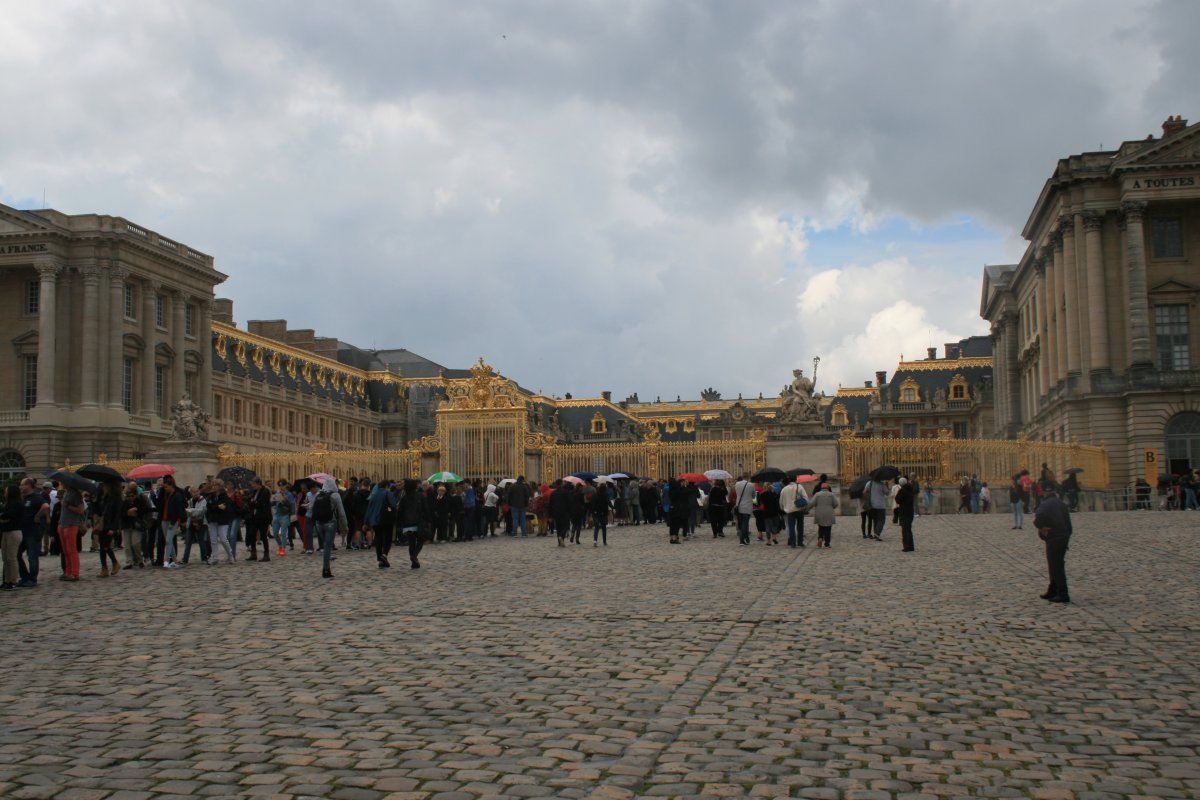 |
|
| Inside the golden gates and in the Royal Courtyard. |
| |
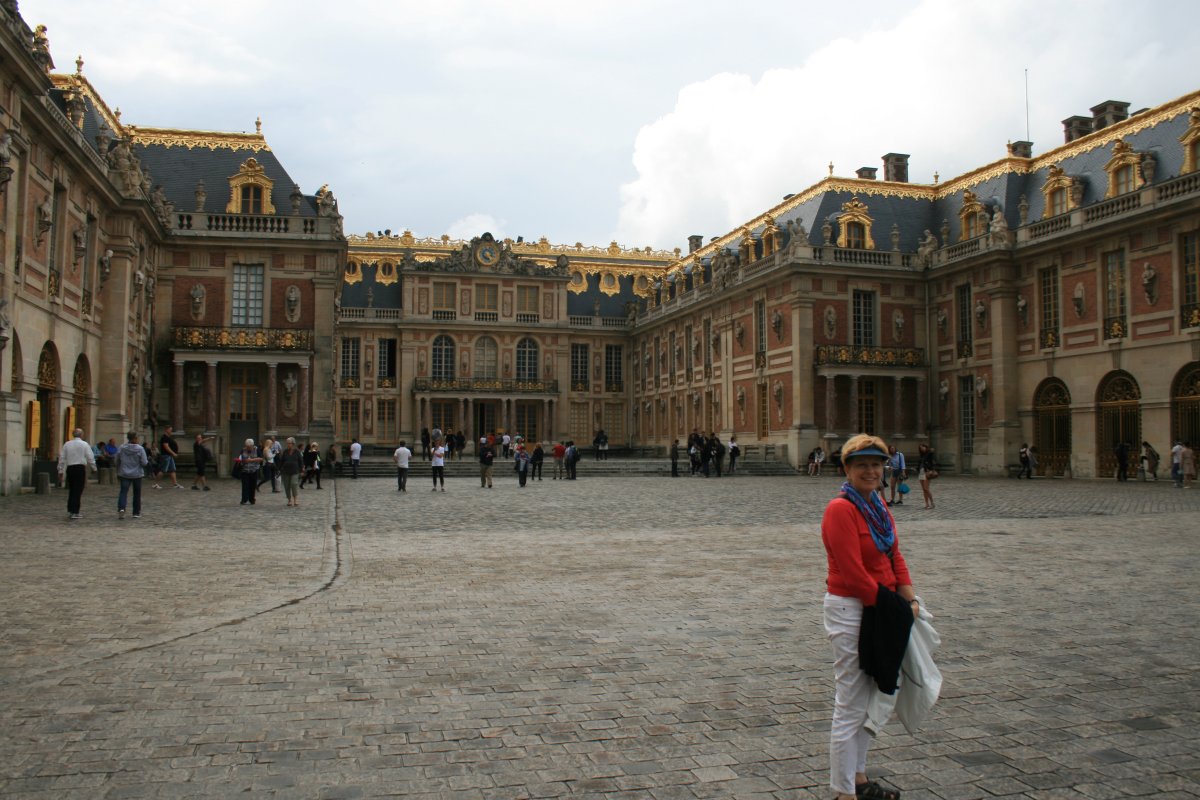 |
|
|
We started out by walking through some rooms on the ground floor between the Chapel and the Opera that have been turned into a history of the palace. Here is a painting that shows the Palace back in its earliery days around 1668, under Louis XIV, the Sun King. (he called himself the Sun King because he gave life and warmth to all he touched)
|
| |
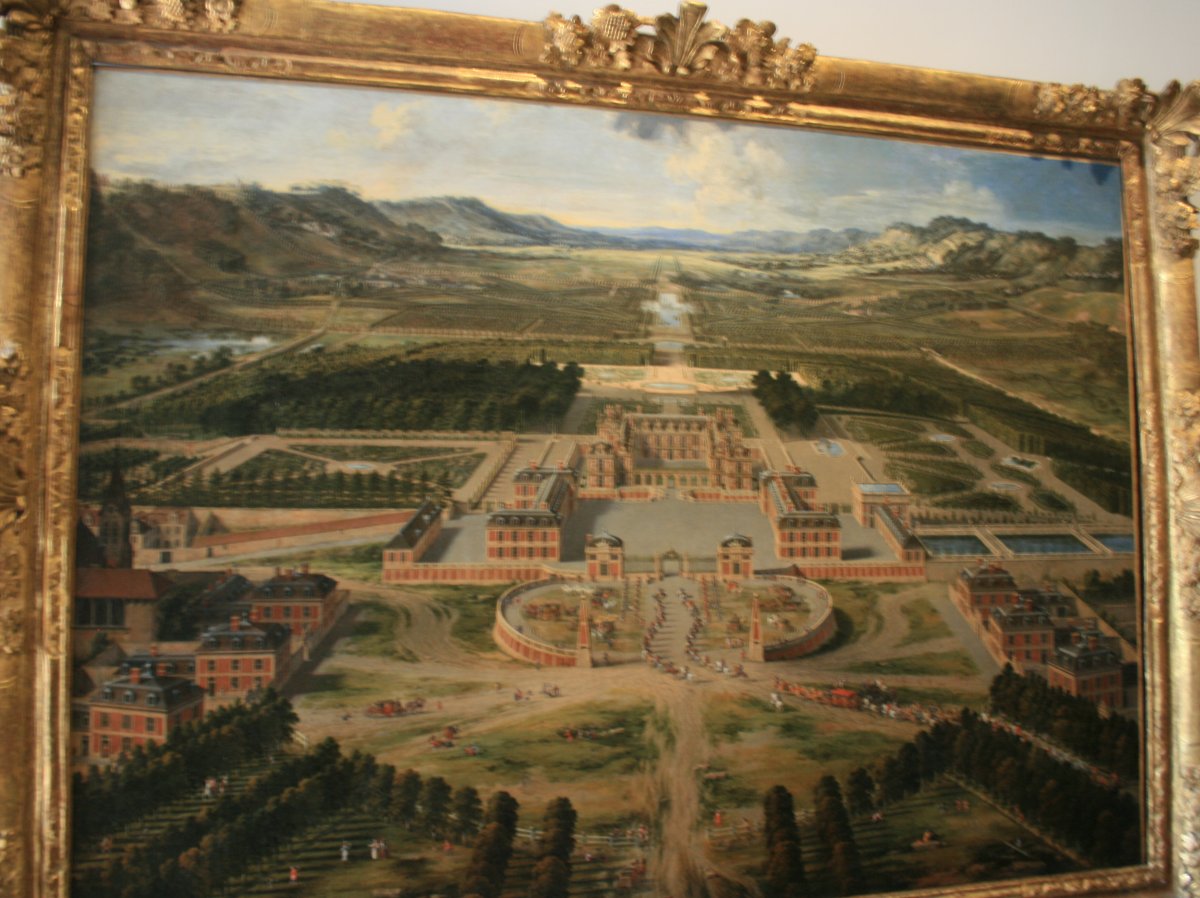 |
|
|
The aerial now, only looking the opposite direction as above.
Photo by By ToucanWings, Wikipedia
|
| |
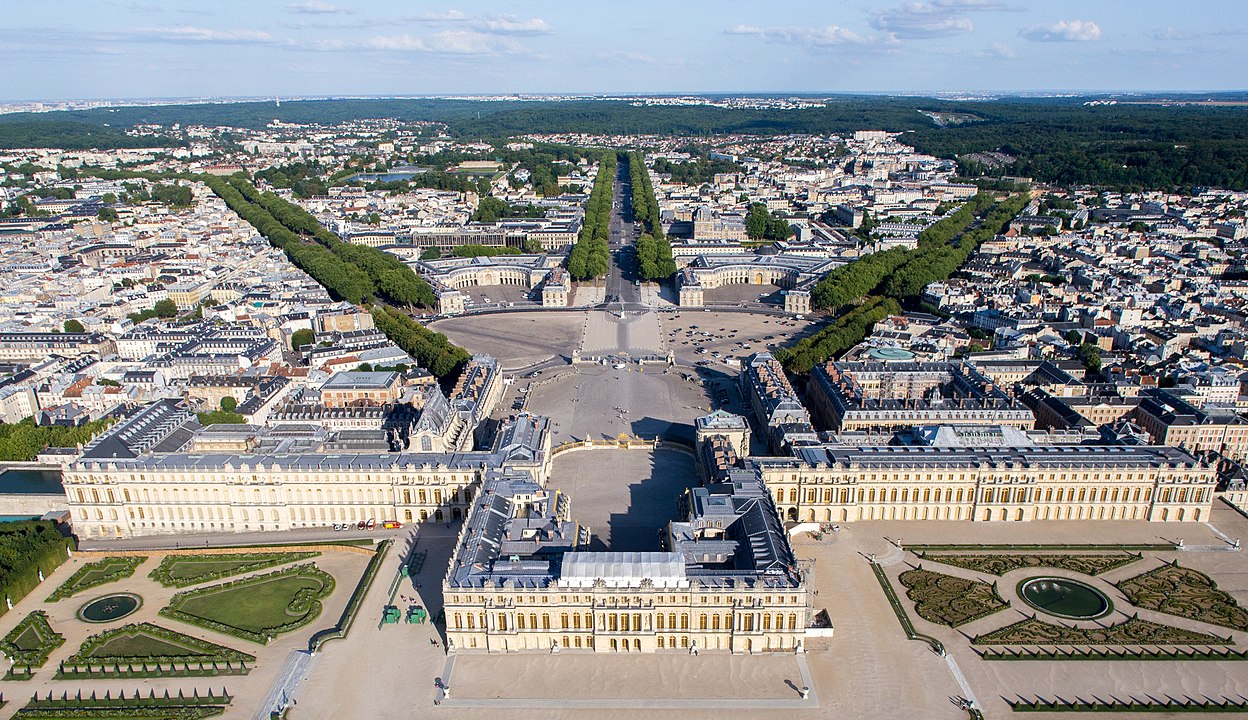 |
|
| There wasn't a tour. You just sort of moved along with the crowd flow. |
| |
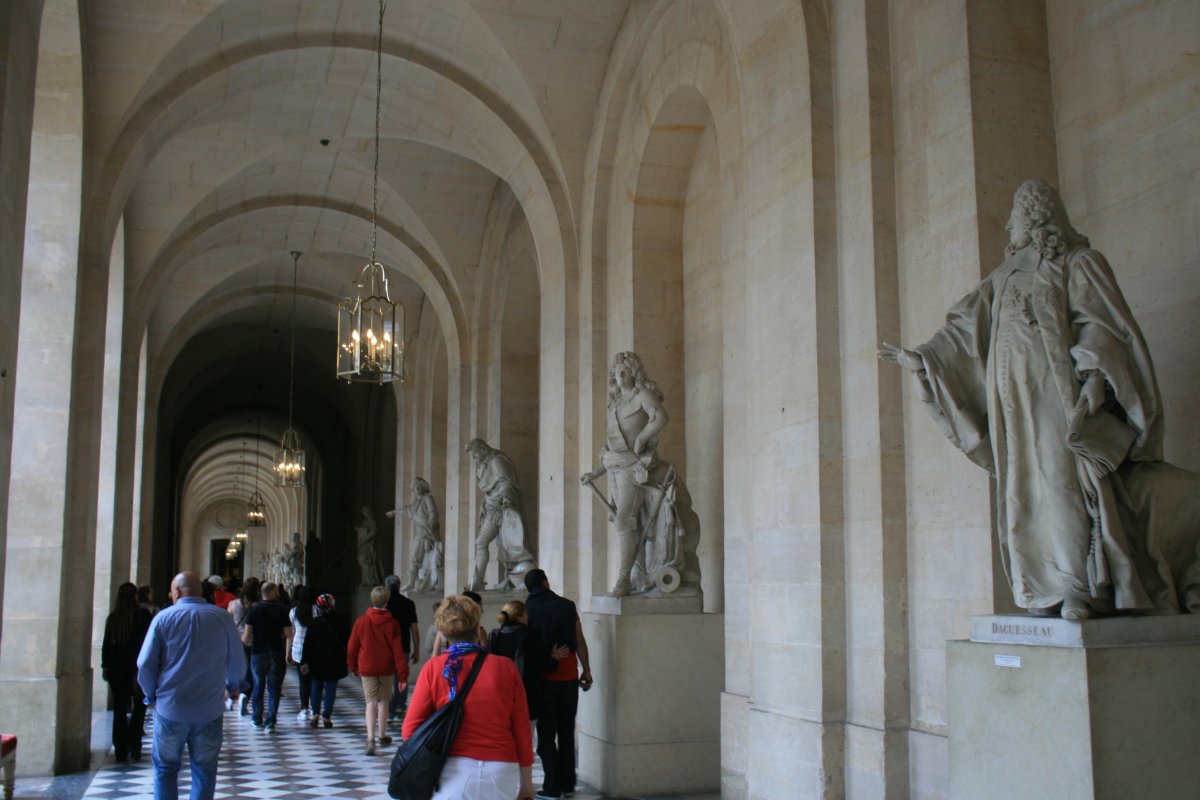 |
|
| Impressive marble statue. |
| |
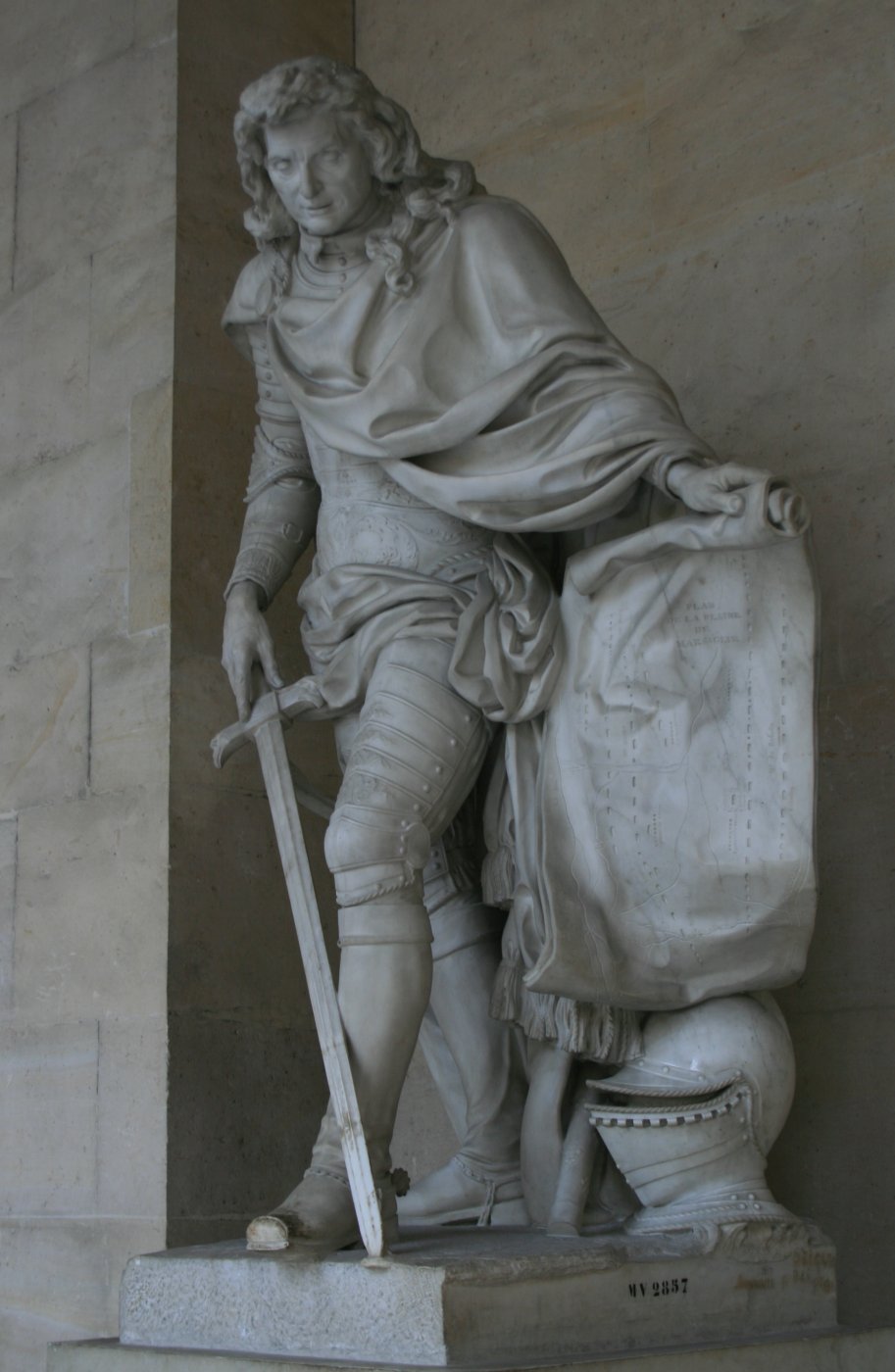 |
|
| The giant, magnificent Salon of Hercules, largest room in the the Palace. This room was originally a chapel. It was rebuilt beginning in 1712 as a showcase for the painting Chist's Meal at the House of Simon the Pharisee by Paolo Veronese, which was a gift to Louis XIV from the Republic of Venice in 1664. The painting on the ceiling, The Apotheosis of Hercules, by François Lemoyne, was completed in 1712, and gave the room its name. |
| |
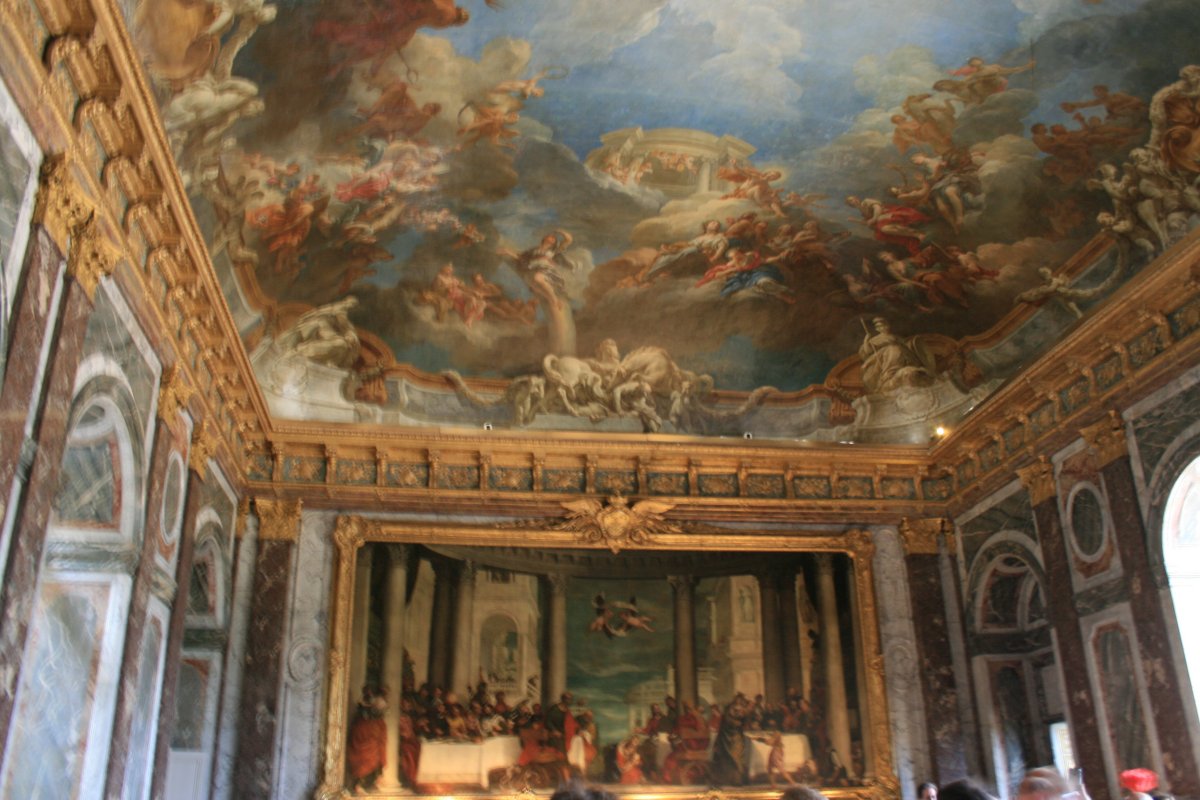 |
|
|
The other end of the Salon of Hercules.
|
| |
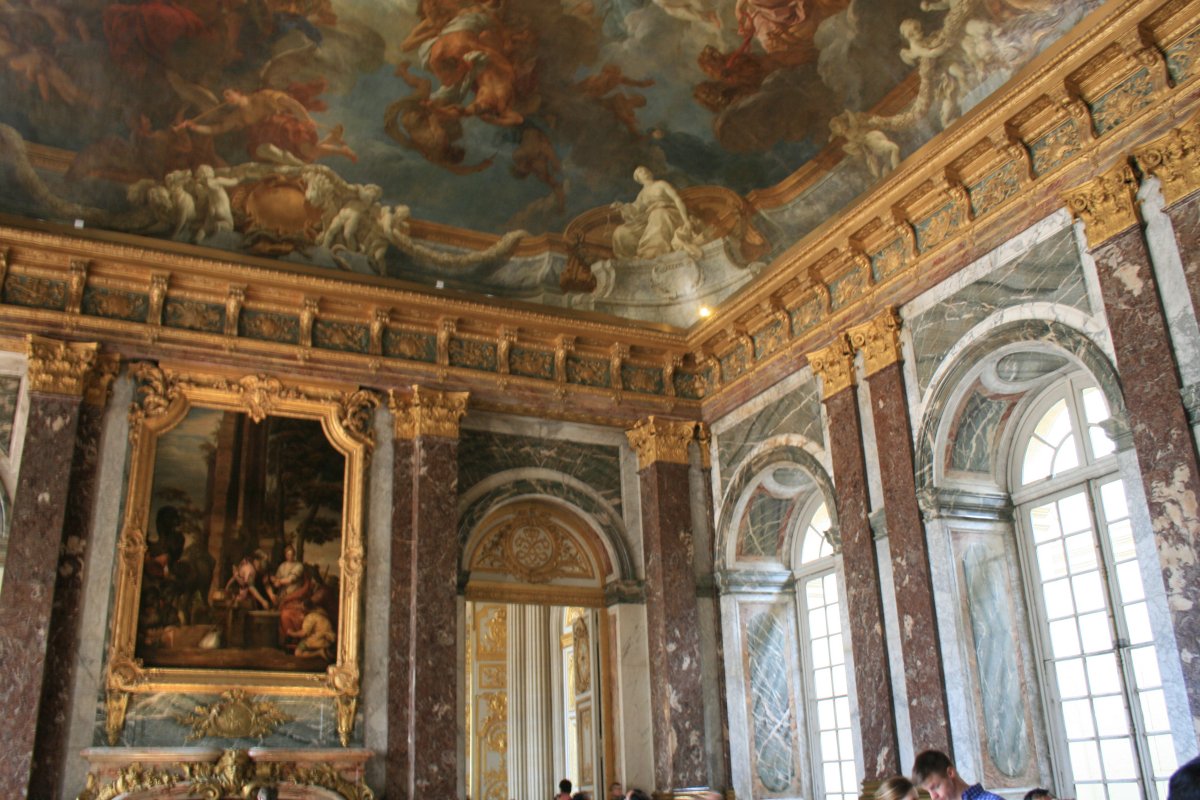 |
|
|
A sculpture of Louis XIV in the Salon of War or War Drawing-Room
|
| |
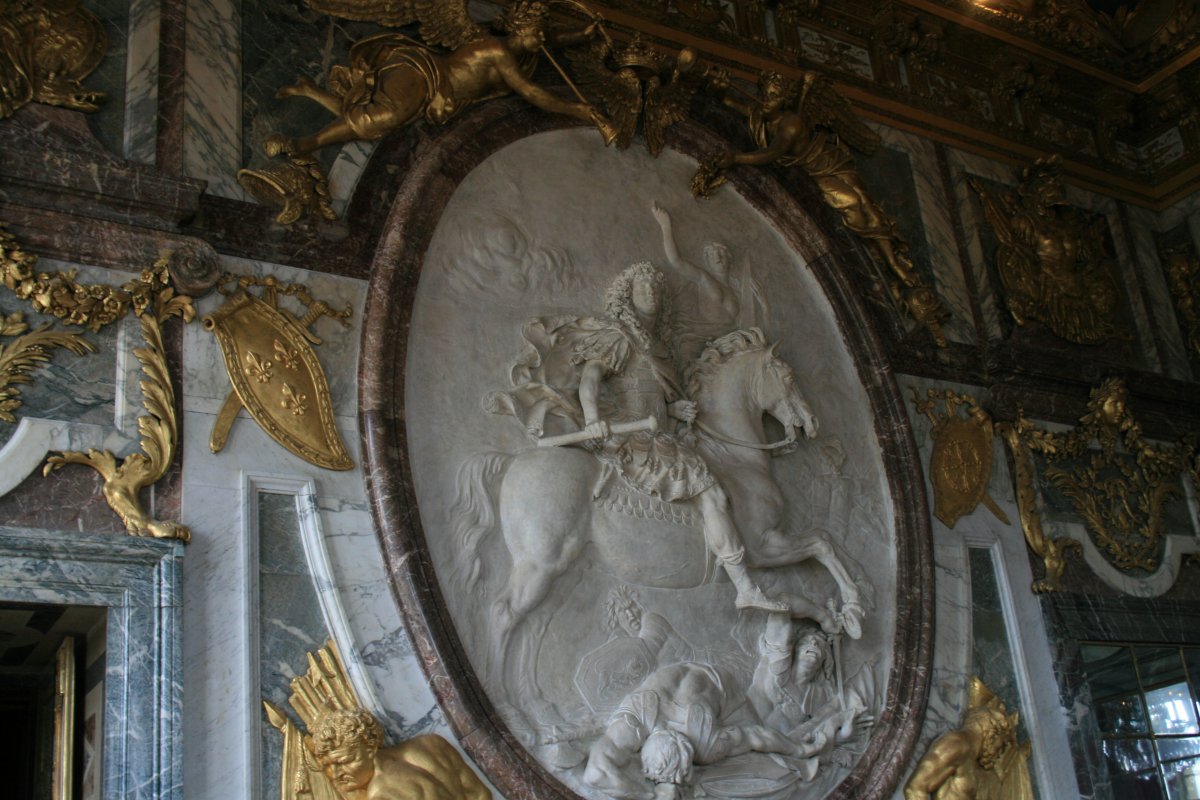 |
|
|
I vaguely remember looking into the Royal Chapel but I don't think we got to see the State Apartments, the King's Wing which included the King's official bedroom, throne room and war rooms, or the Queen's Wing, with Queen's bedchamber, the guard room where Louis XVI and Marie-Antoinette surrendered to the Revolution, and Napoleon's coronation room. Maybe they were closed for renovation? Looking back, we missed quite a bit.
We did get to see the most famous room in the château of Versailles: the Hall of Mirrors. "It is 250 feet long, with 17 arched mirrors matching 17 windows looking out upon royal garden views. The mirrors -- a luxury at the time -- reflect an age when beautiful people loved to look at themselves." -- Rick Steves [That's not the case now?]
|
| |
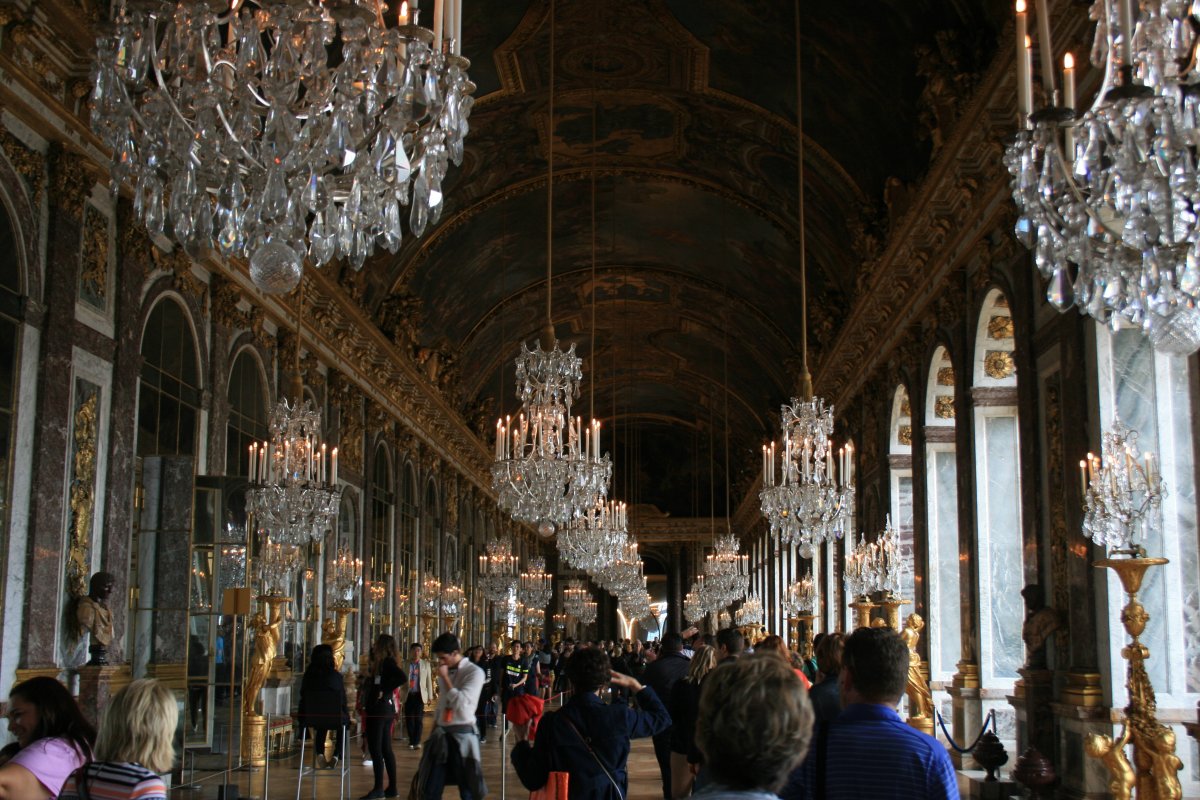 |
|
|
The infamous Treaty of Versailles, formally ending the First World War, was signed here in the Hall of Mirrors in June, 1919.
The vaulted ceiling is entirely covered with paintings by Le Brun, telling the story of Louis XIV.
Hall of Mirrors was not only used for receptions and special occasions, but more commonly used as a passageway from the King's Apartments to those of the Queen.
|
| |
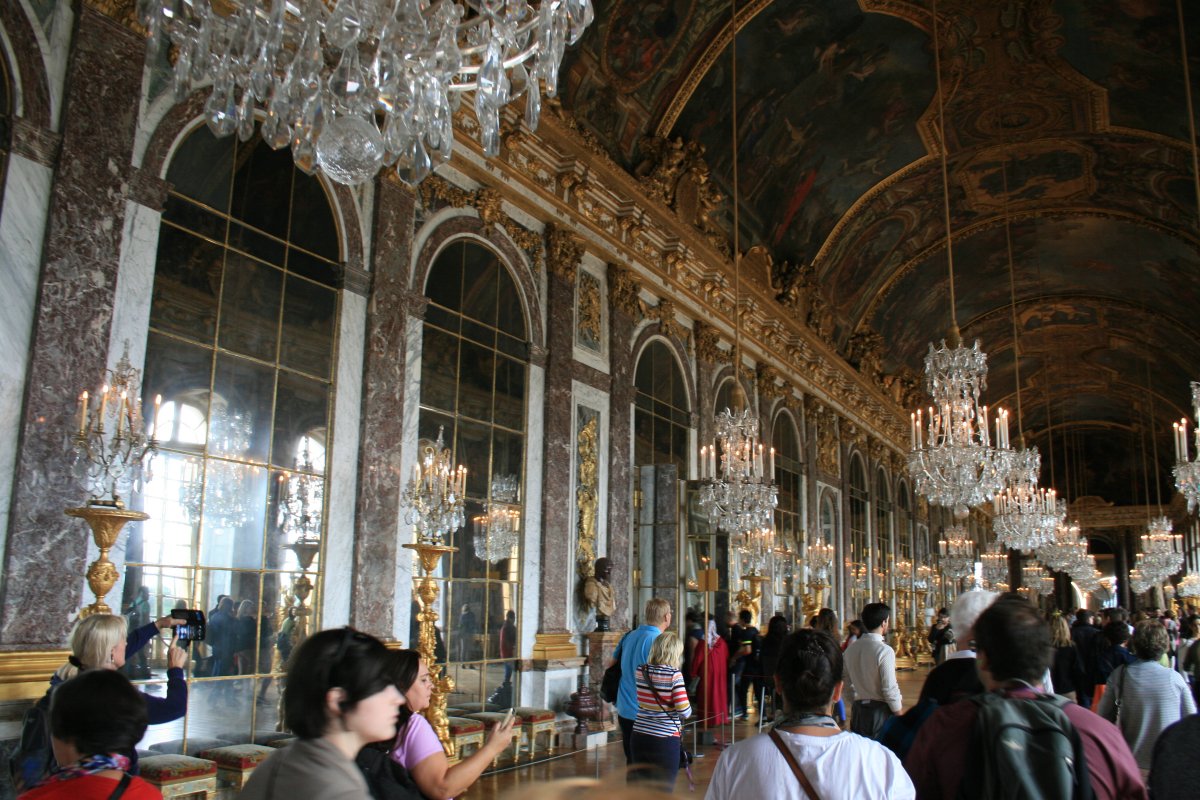 |
|
| The Hall of Mirrors recently finished restoration in 2006. It looks pretty good! |
| |
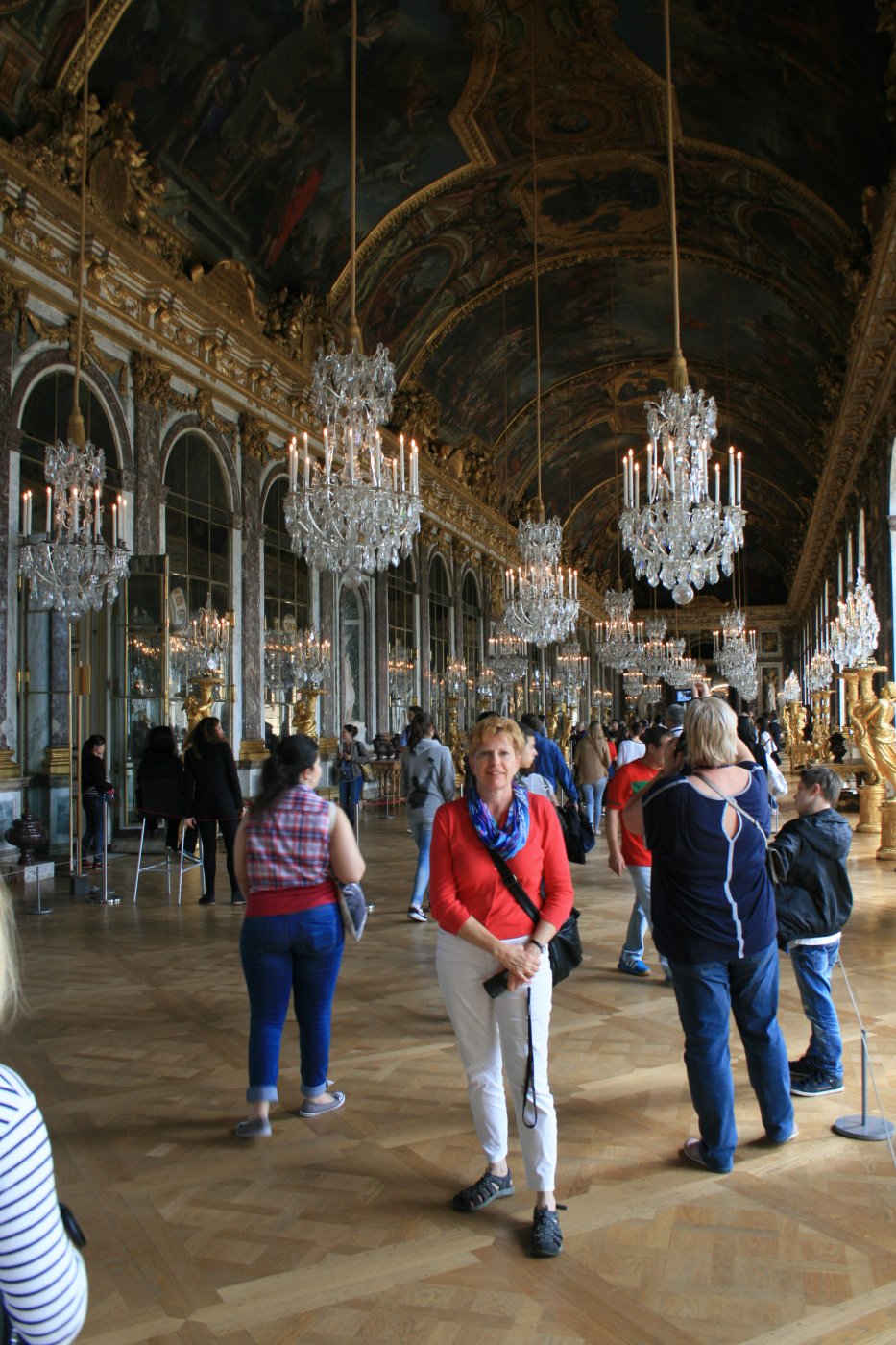 |
|
| It's not only the building itself, but the incredible works of art -- statues, paintings, and in the case below lamp bearers -- that make for an amazing place. |
| |
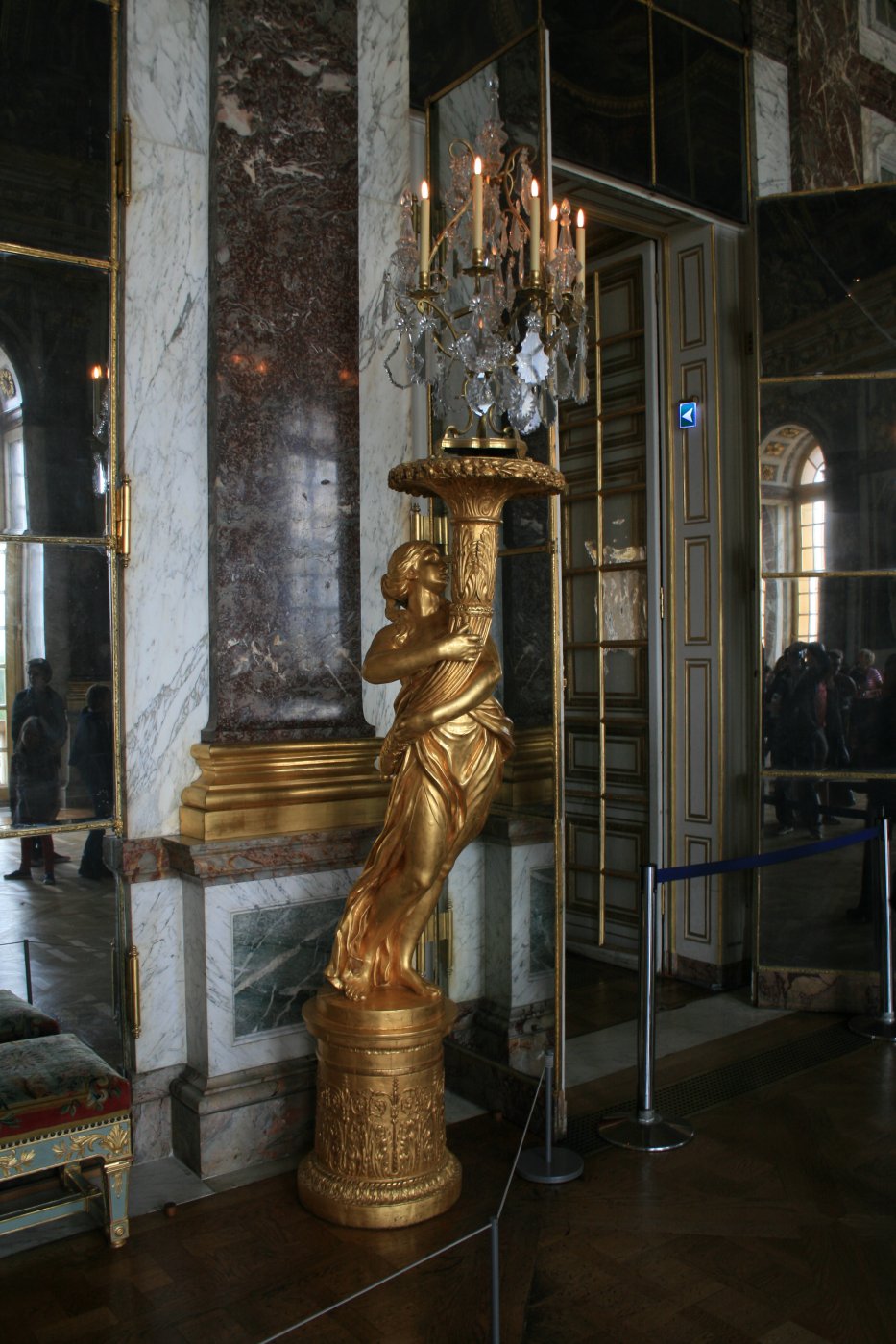 |
|
|
The statue, the walls of different shades of marble, the gold carvings -- magnificent.
|
| |
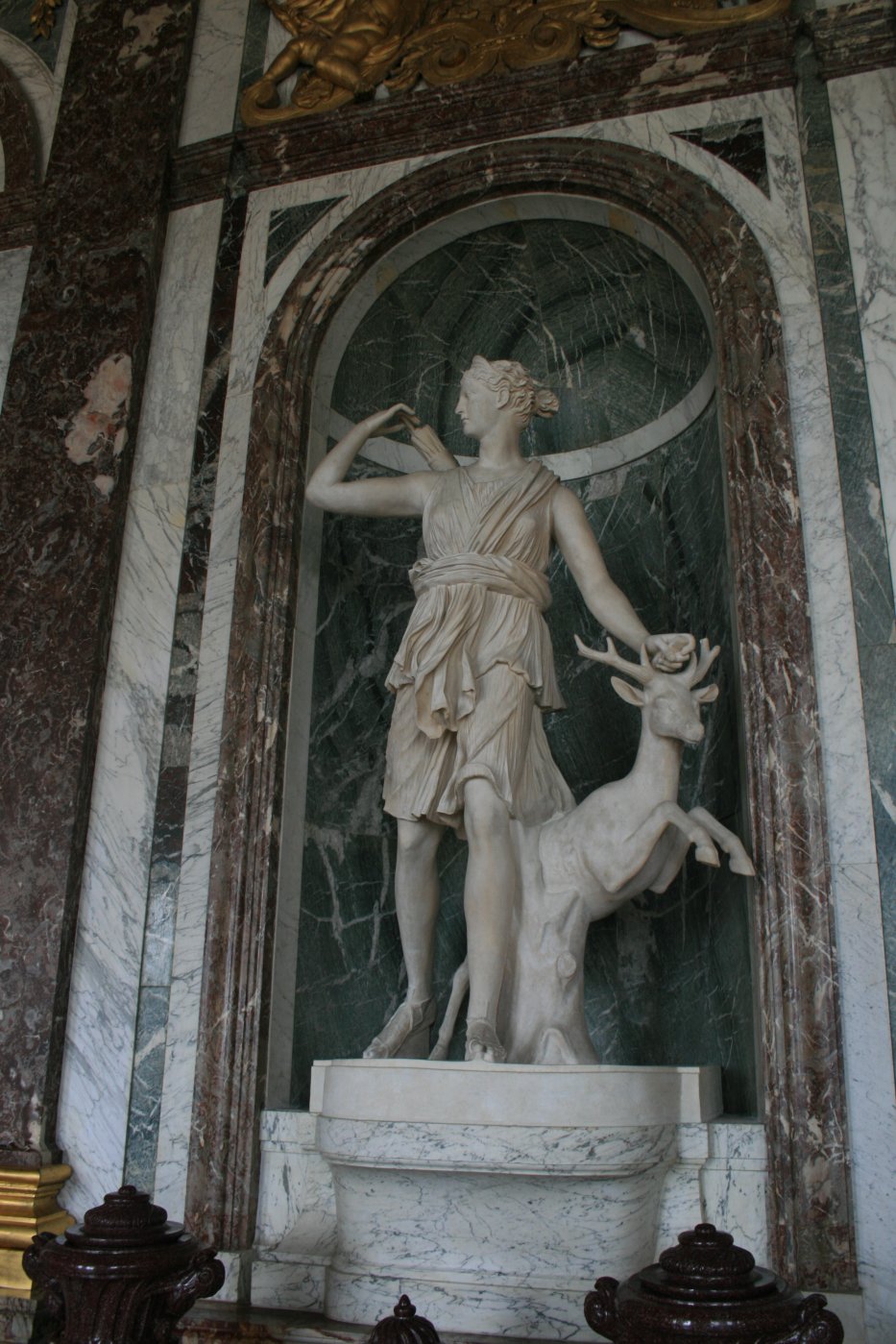 |
|
|
A great look at the Hall of Mirrors without the crowds. Photo by Myrabella - Wikimedia
|
| |
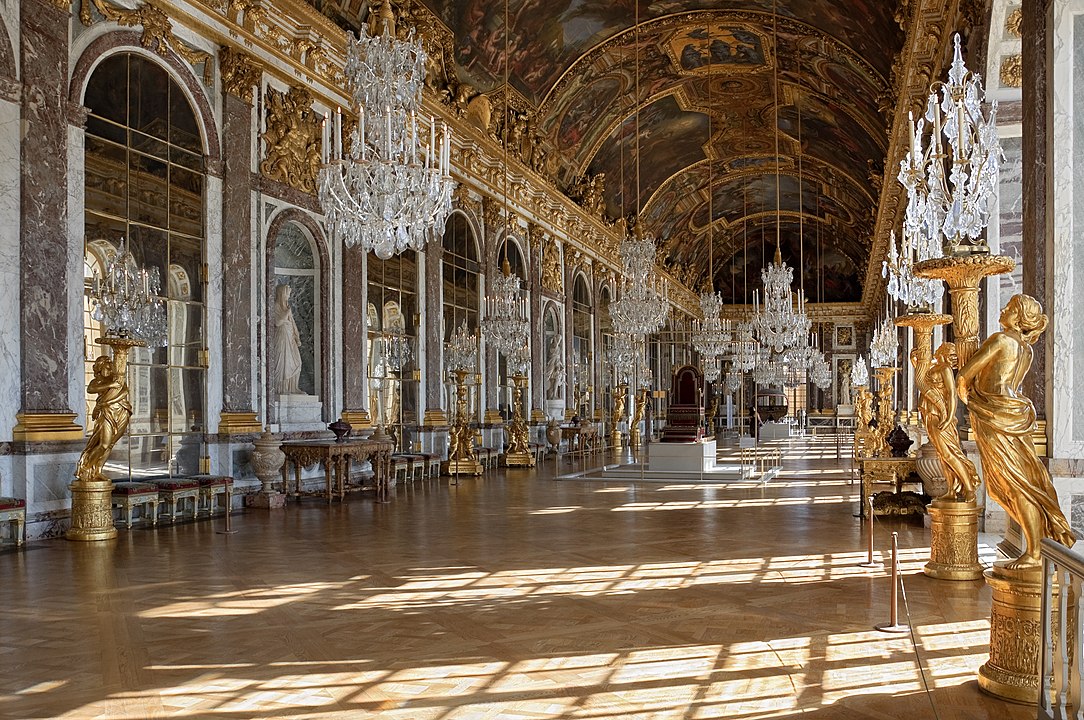 |
|
| Then down these fancy stairs and out -- that was it for the inside of the Palace. |
| |
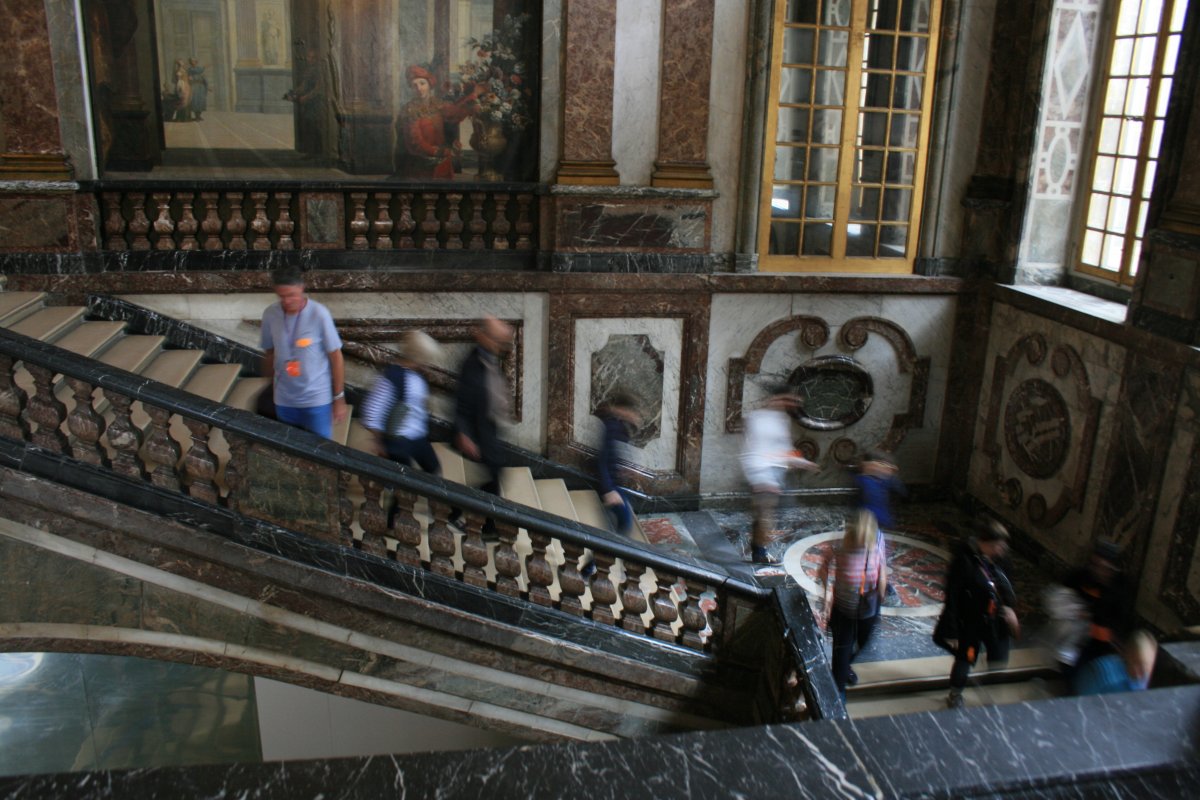 |
|
|
Back outside in the Marble Court, surrounded by the State Apartments. The original Chateau facade is to the left.
|
| |
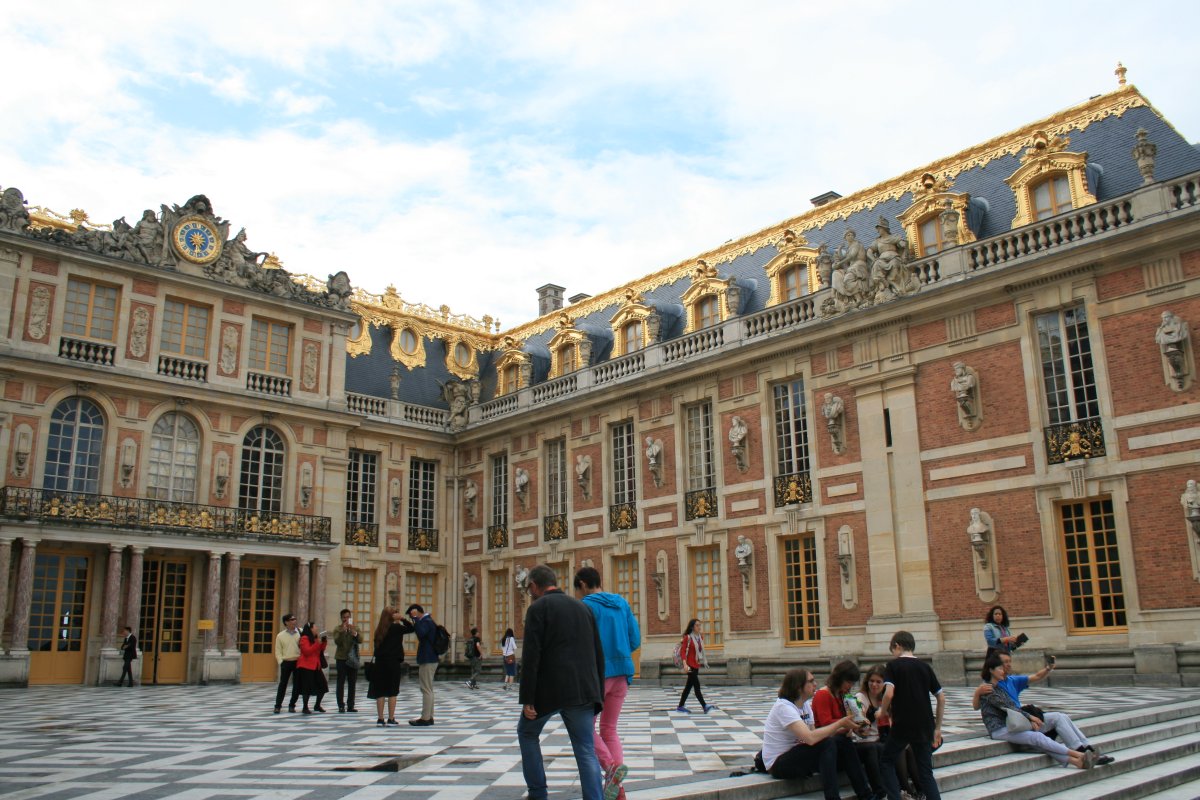 |
|
|
"Louis XIV was creating the first modern, centralized state. At Versailles he consolidated his government's scattered minitries so that he could personally control policy. More importantly, he invited France's nobles to Versailles in order to control them. Living a life of almost enforced idleness, the "domesticated" aristocracy couldnt interfere with the way Louis ran things. With 18 million people united under one king, a booming economy and a powerful military, France was Europe's number-one power. Around 1700, Versailles was the cultural heartbeat of Europe and French culture was at its zenith. Throughout Europe, when you said "the king" you were referring to the French king -- Louis XIV. For all his grandeur, he was one of history's most polite and approachable kings, a good listener who could put even commoners at east in his presence. For 70 years Luis XIV was the perfect embodiment of the absolute monarch. He summed it up best himself with his famous rhyme -- "L'etat, c'est mois!" (The state, that's me!) -- Rick Steves
Looking at the rear for Versailles. You look at how big the Palace is -- and this is only maybe half of it -- and you realize how little of the inside we actually got to see as regular Joe tourists.
The Hall of Mirrors is behind Lynnette on the middle floor.
|
| |
 |
|
| We were lucky that the fountains came on just as the sun emerged to light up the beautiful Fountain of Latona. |
| |
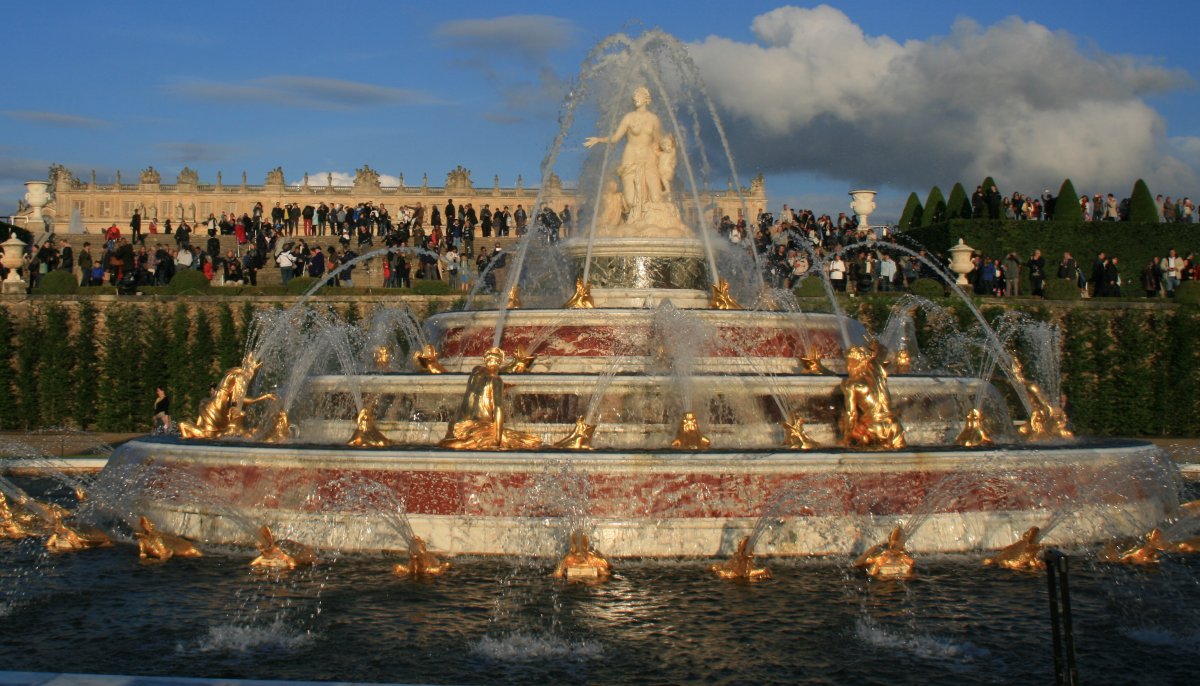 |
|
|
|
| |
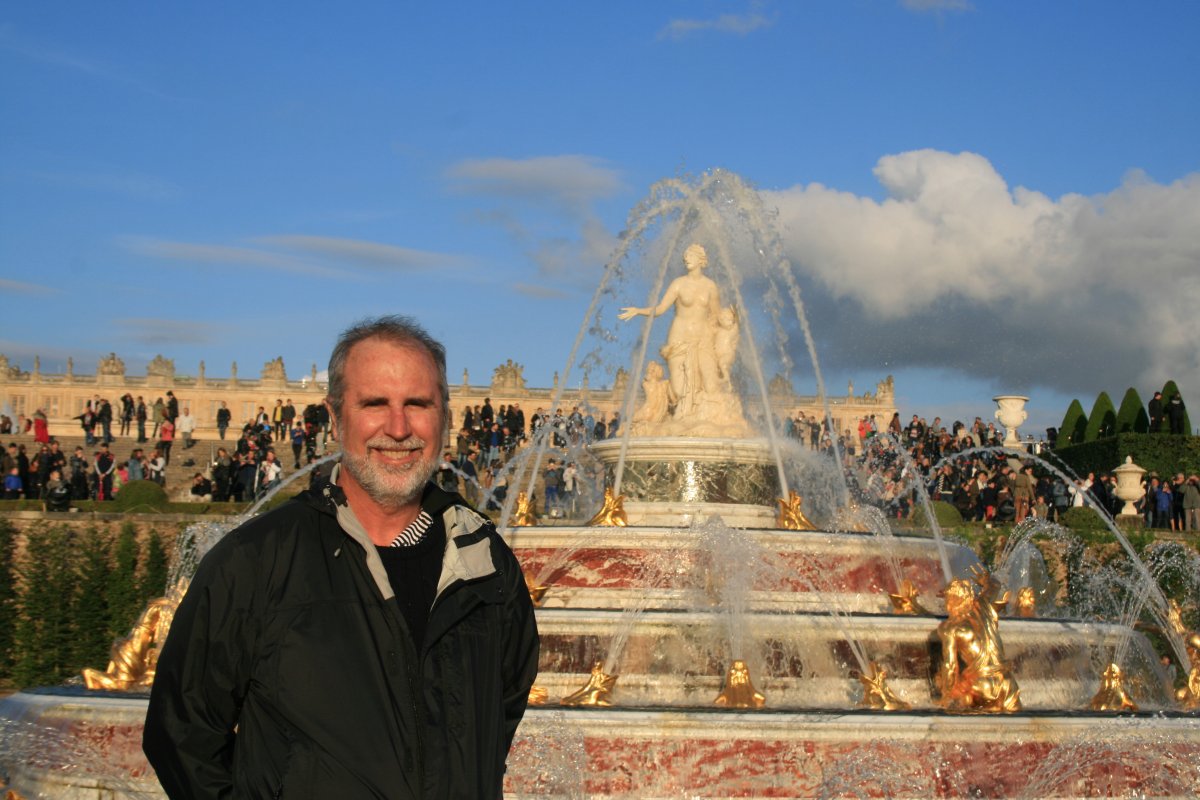 |
|
|
The Latona Fountain illustrates the story of Latona taken from the Metamorphoses of Ovid. According to the story, when the peasants of Lycia insulted Latona, the mother of Apollo and Diana, the god Jupiter transformed the peasants into frogs.
The fountain was begun in 1670 by Le Nôtre, then enlarged and modified by Hardouin-Mansart in 1686. The main statuary group of Latona with Diana and Apollo was created between 1668-1670 by the sculptor Gaspard Marsy and originally placed on a modest foundation of rocks in the middle of the basin. Gaspard's brother Balthazard designed six lead half-human, half-frog figures to grace the water spouts surrounding the Latona statue, with 24 cast lead frogs positioned on the grass surrounding the perimeter of the fountain.
In 1686 Hardouin-Mansart made the fountain much grander by building four oval tiers forming a pyramid, topped by Gaspard Marsy's statue and enhanced all around with the semi-human figures of Balthazard Marsy and an assortment of gilded frogs and lizards sculpted by Claude Bertin. The four tiers are covered in 230 pieces of marble, composed of the white and grey-veined Cararra, greenish marble from Campan, and red marble from Languedoc.
|
| |
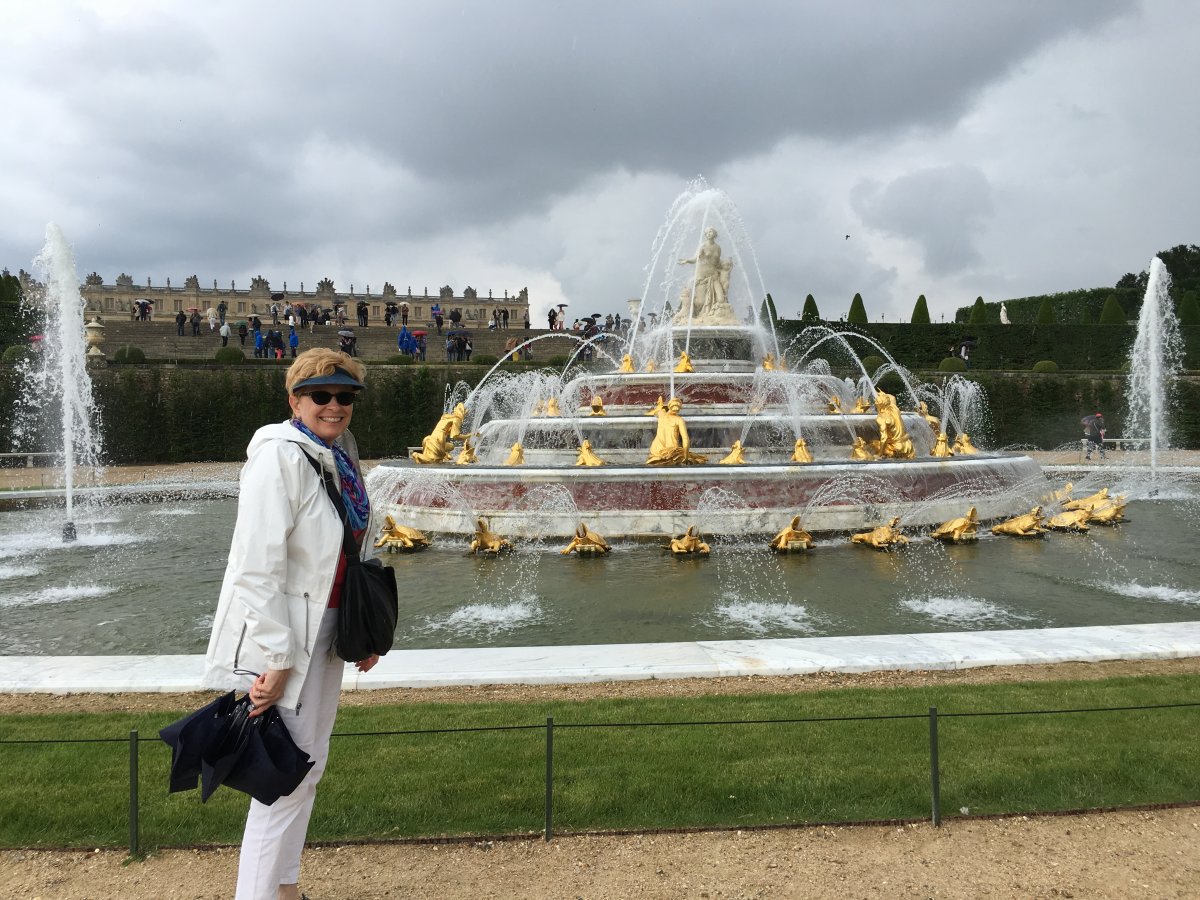 |
|
|
Looking at the Fountain of Latona with the Grand Canal in the background.
|
| |
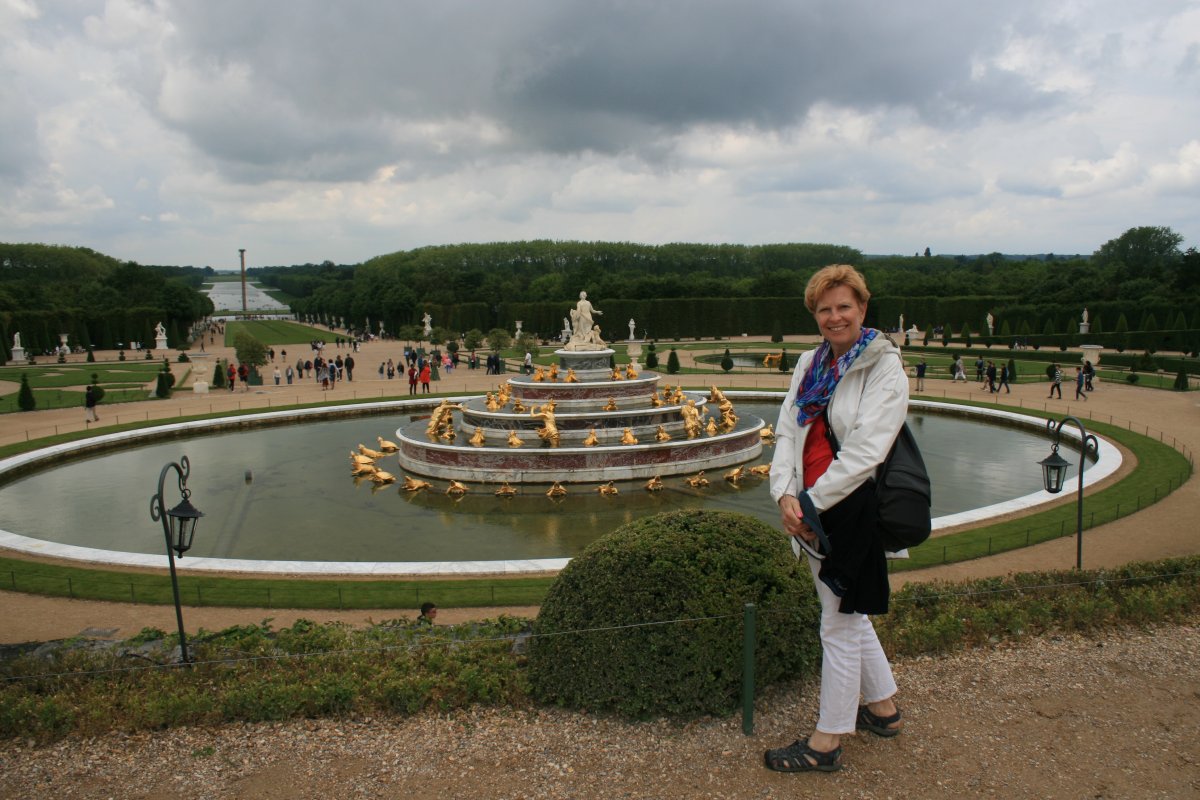 |
|
|
We headed off into the Park, or Garden.
|
| |
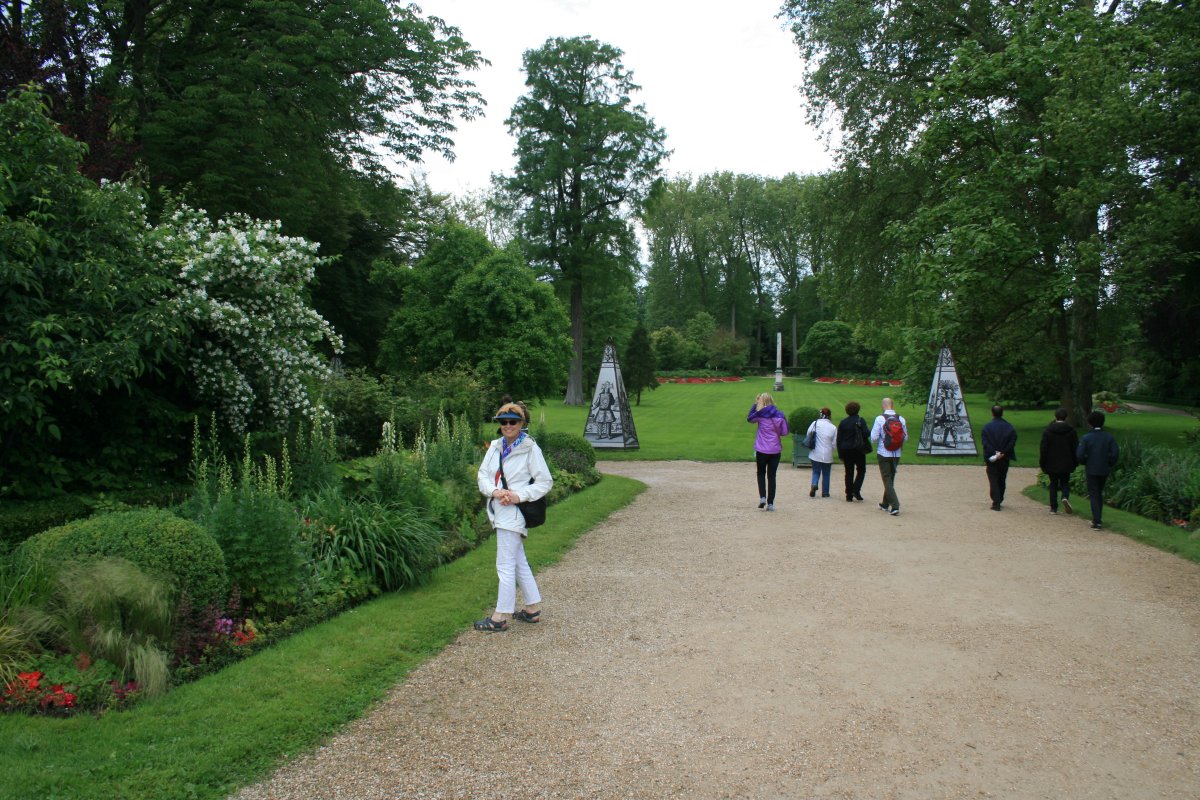 |
|
| |
| |
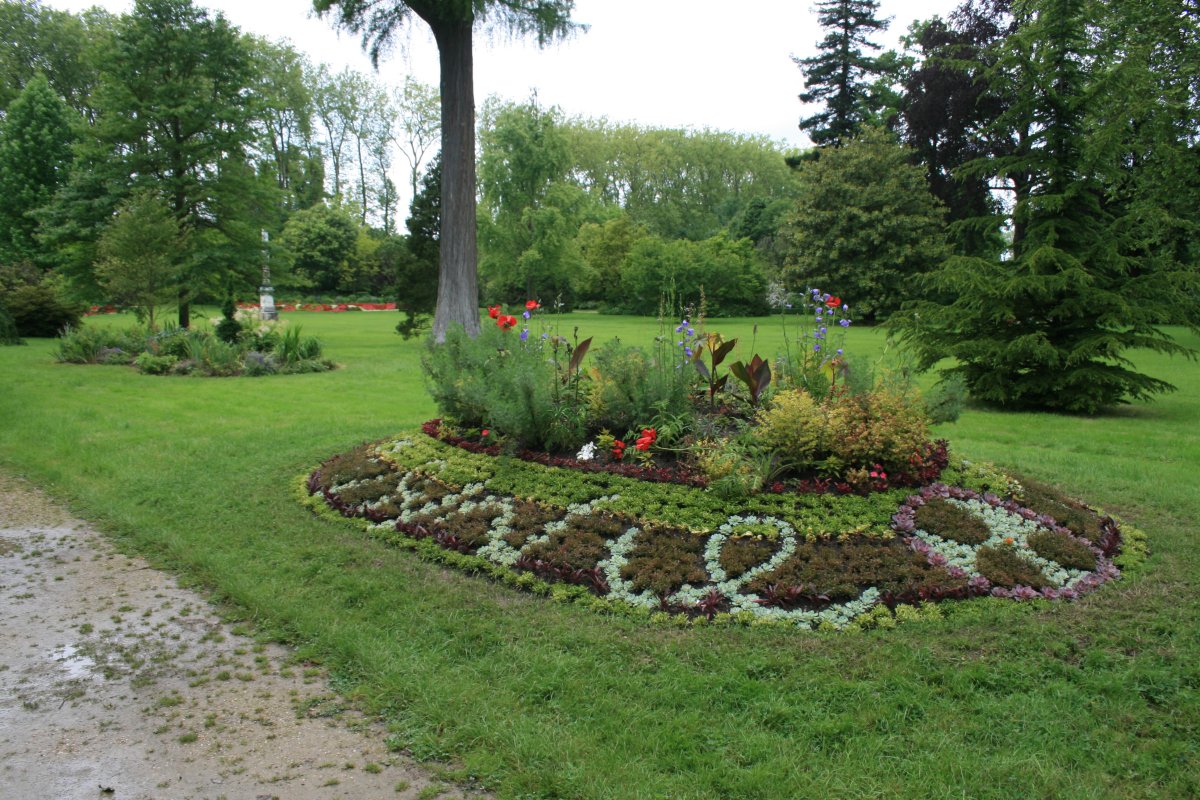 |
|
|
|
| |
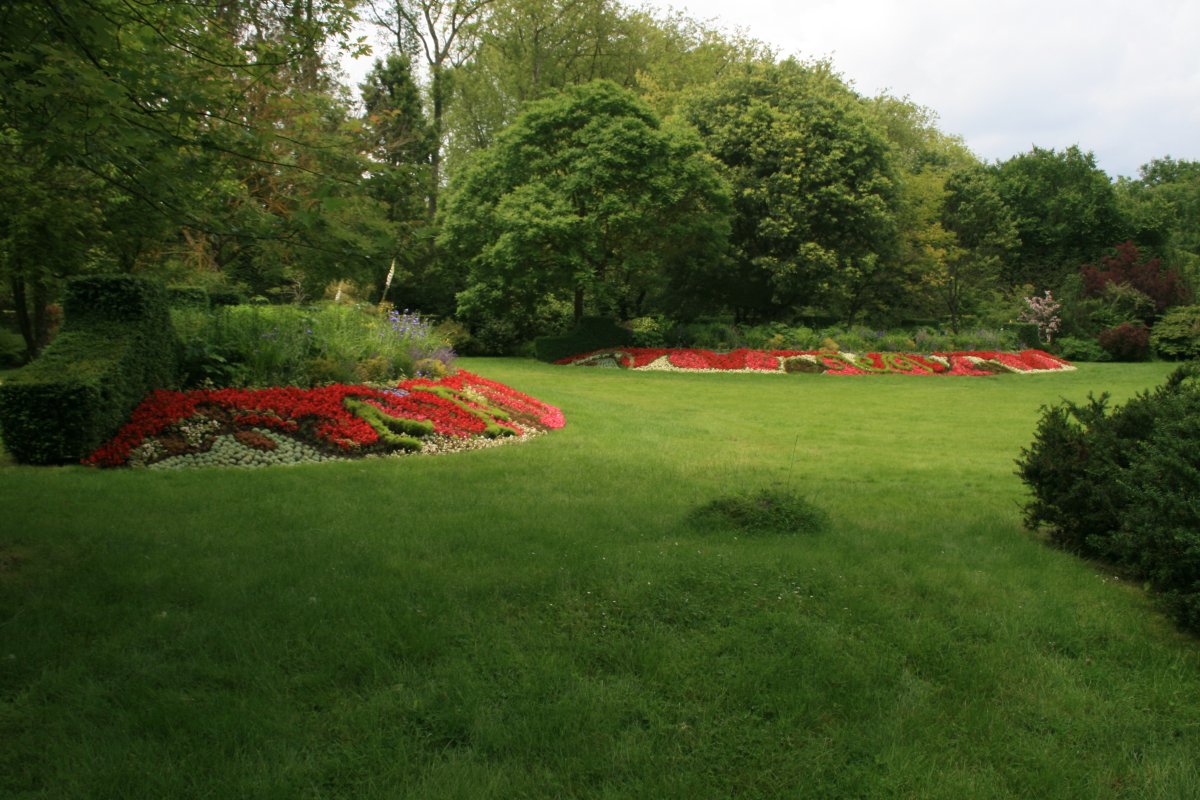 |
|
| The Colonnade Bosquet with the water fountains just coming on. |
| |
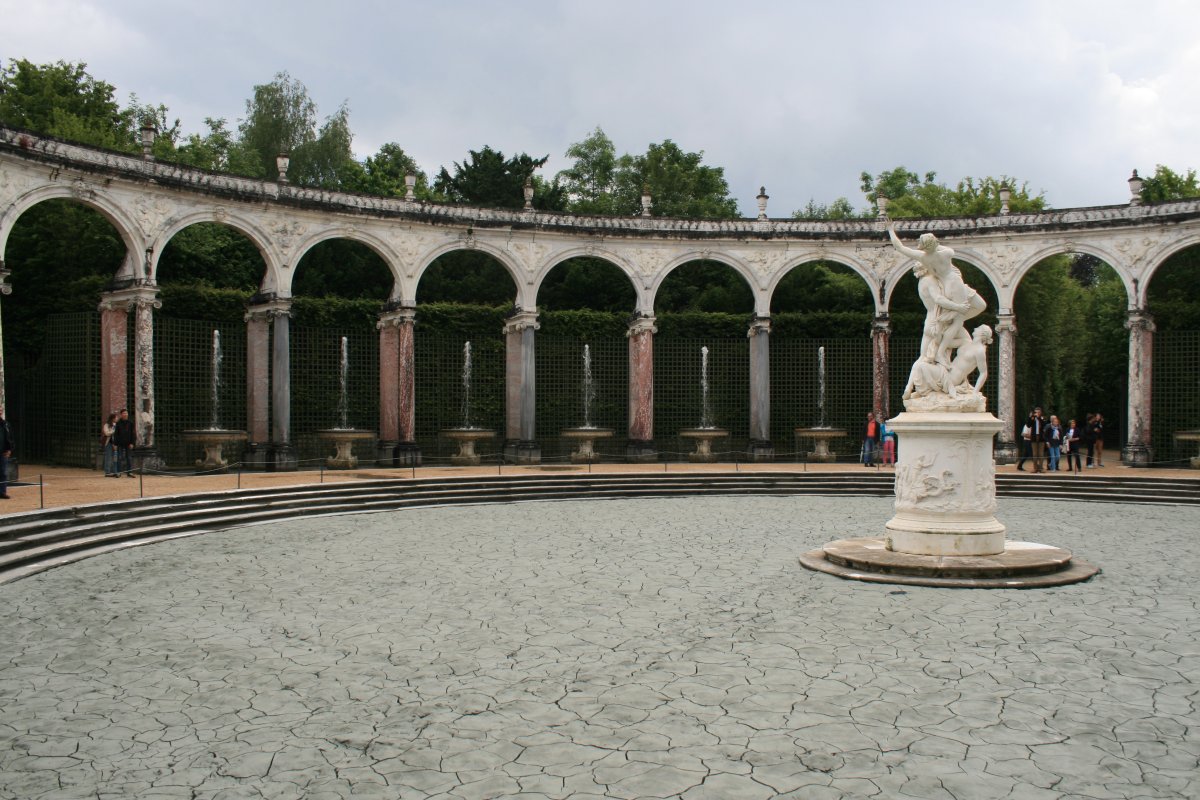 |
|
|
The Apollo Basin. Fountain of the Chariot of Apollo near the Grand Canal.
|
| |
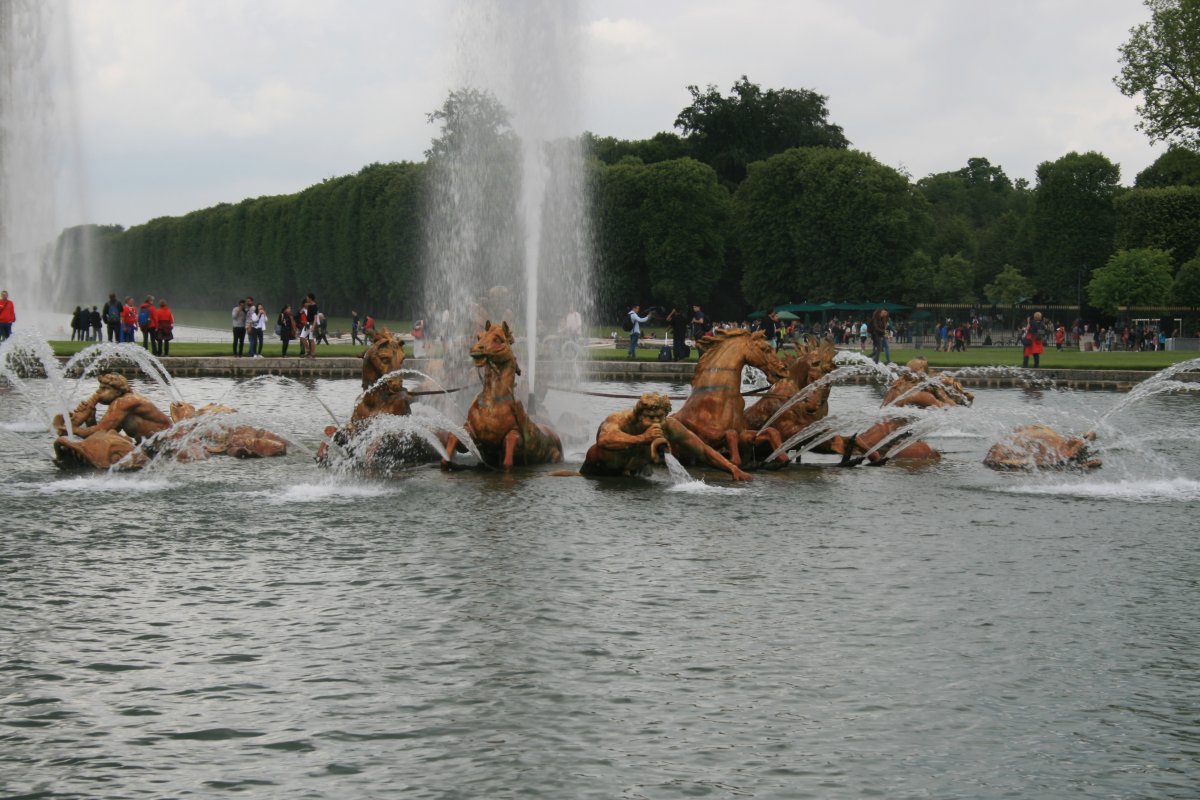 |
|
| |
| |
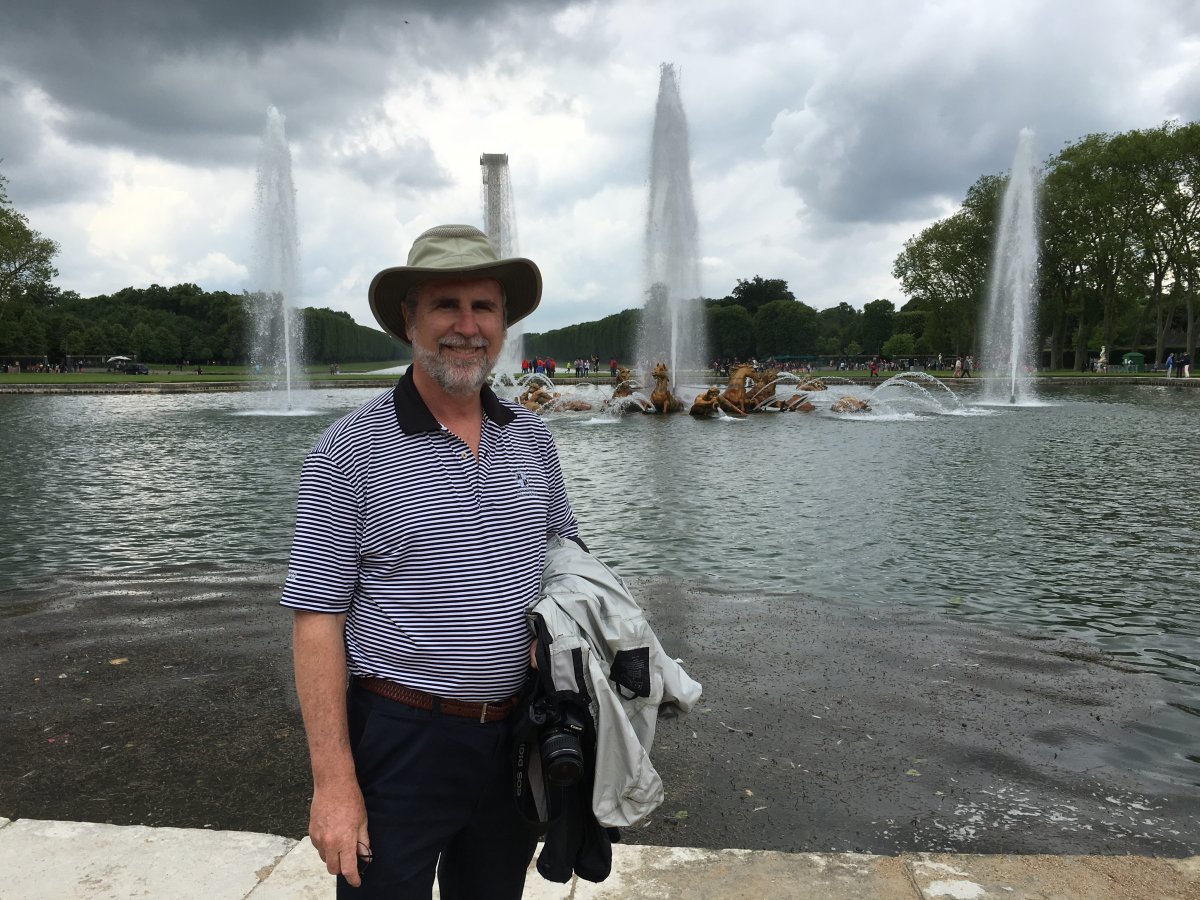 |
|
|
|
| |
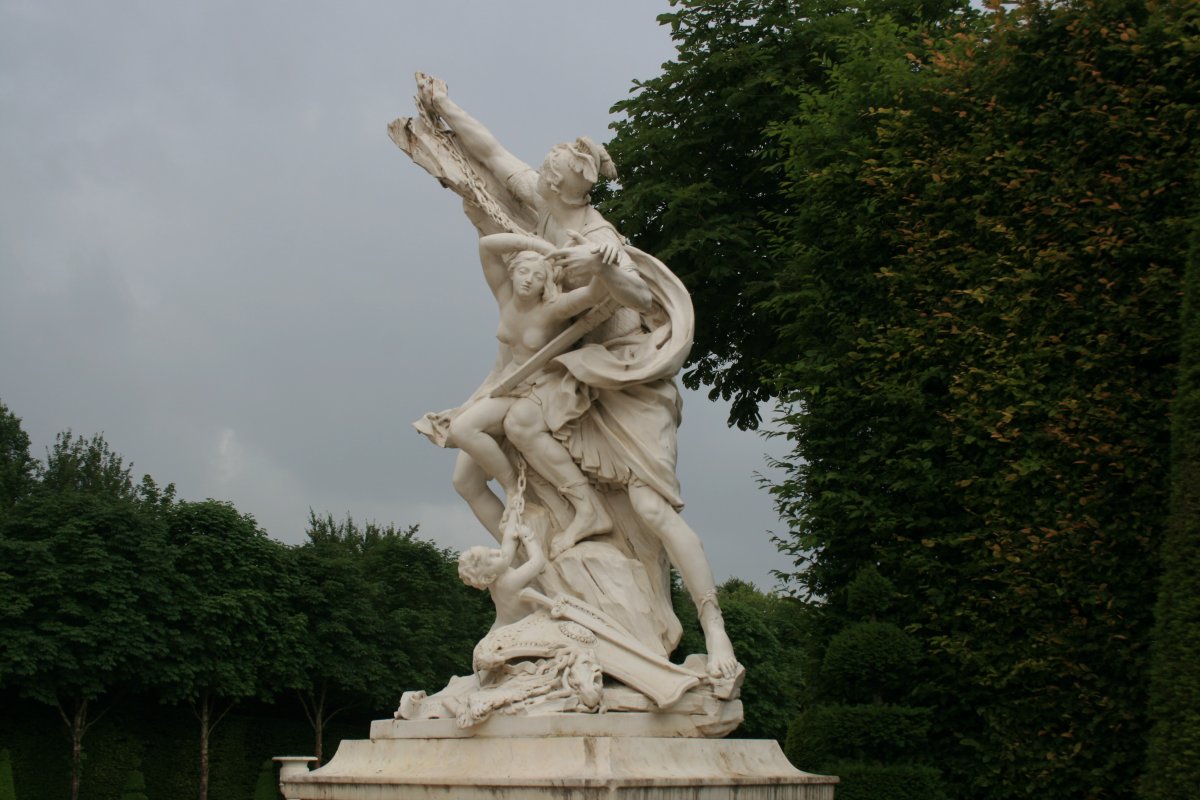 |
|
| |
| |
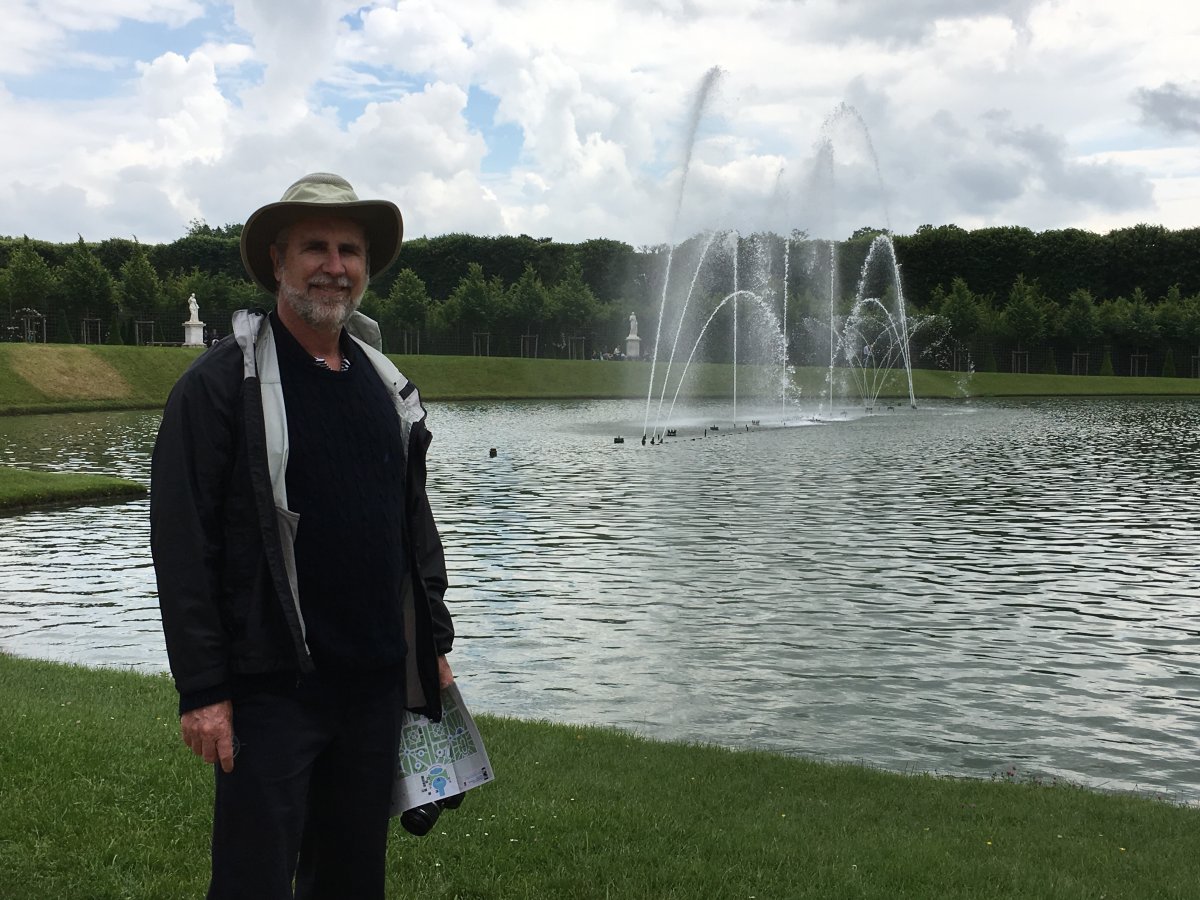 |
|
| You could spend all day in the park. It was huge. |
| |
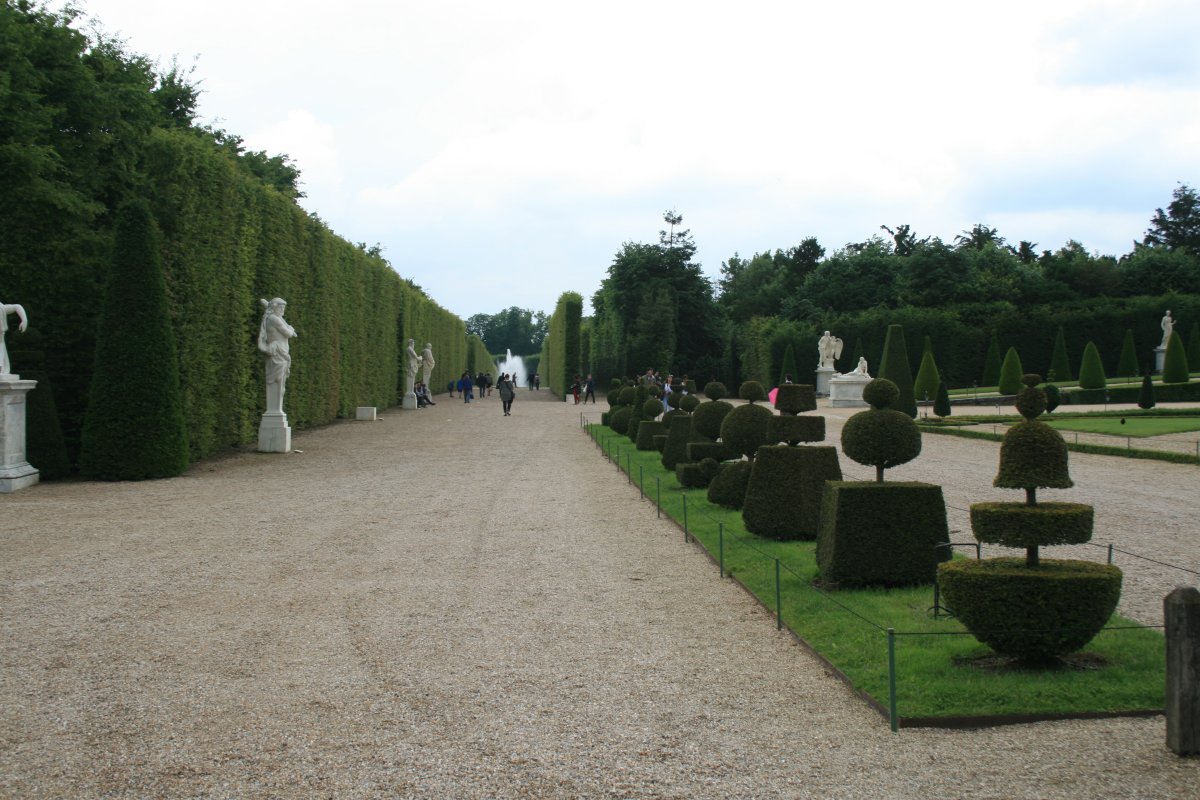 |
|
| The one picture I took of Versailles when my family visited Paris back in 1973. Of all things, I was fascinated with the cone-shaped bushes. I do remember the Hall of Mirrors though. |
| |
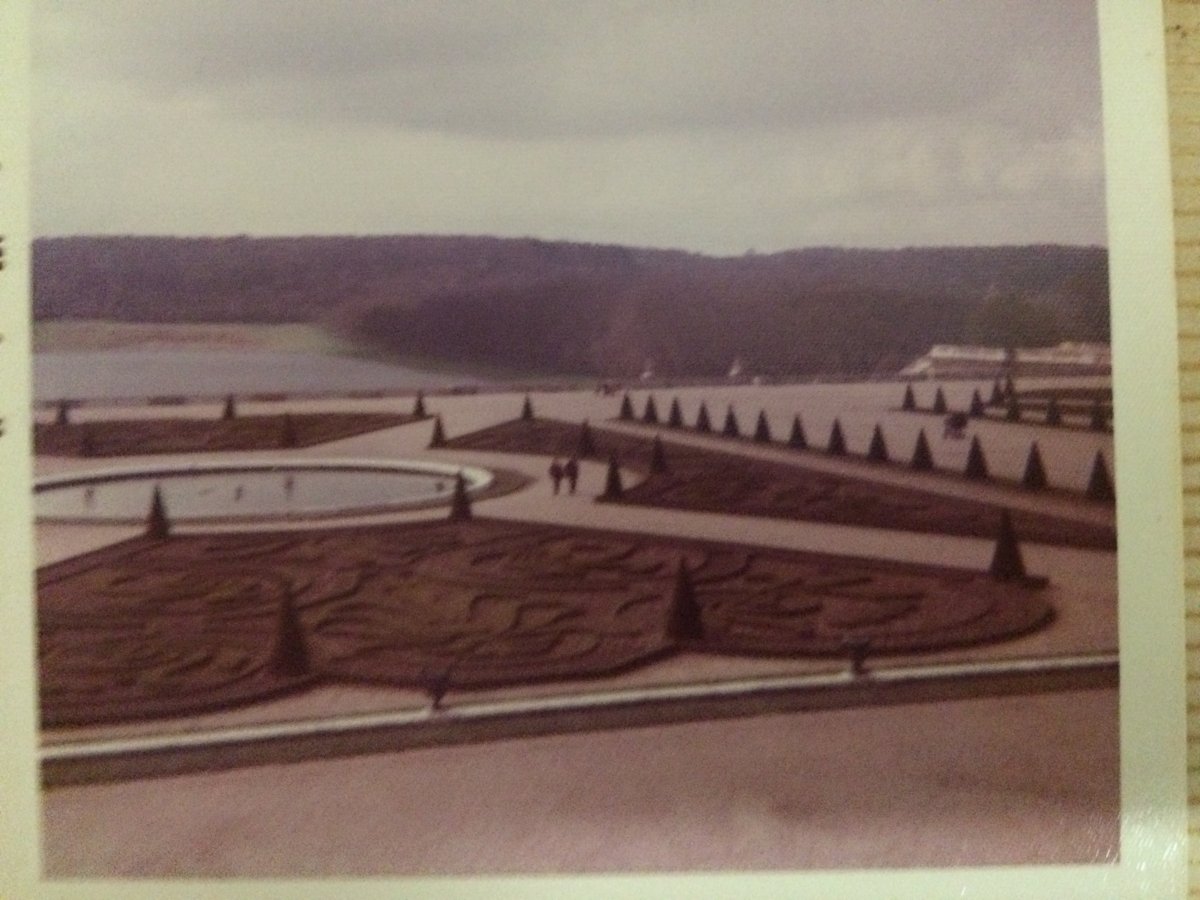 |
|
|
Versailles is the architectural embodiment of the ancien regime, a time when society was divided into rulers and the ruled, when you were born to be rich or to be poor. To some it's the pinnacle of civilization; to others, the sign of a civilization in decay. Either way, it remains one of Europe's most impressive sights. -- Rick Steves.
|
| |
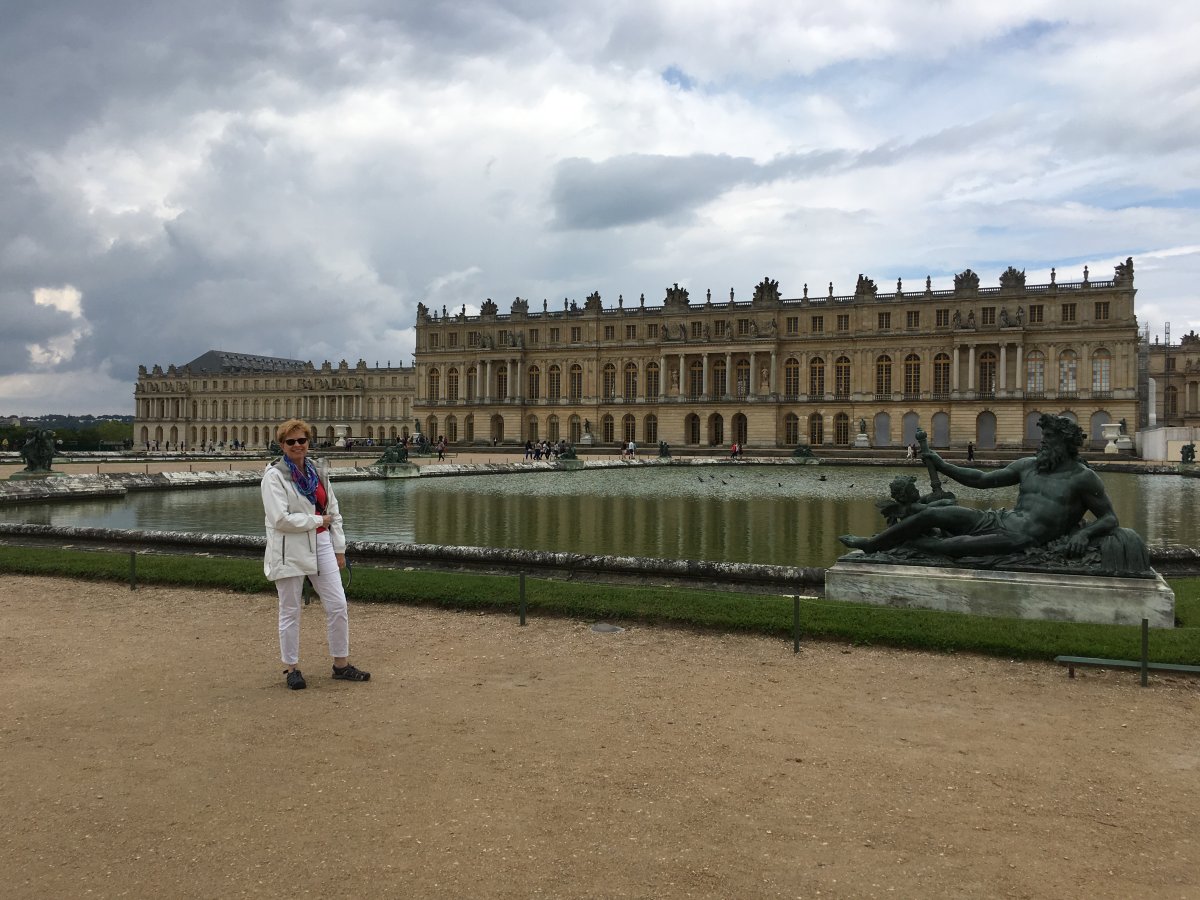 |
|
| I had bought tickets to the "Royal Serenade in the Hall of Mirrors". They were not cheap. I didn't really know what to expect. It turns out it was back into the same rooms we had seen earlier. However, this time it wasn't as crowded and musicians and dancers of the Compagnie Baroque provide entertainment dressed as they were back in the days of the Sun King. |
| |
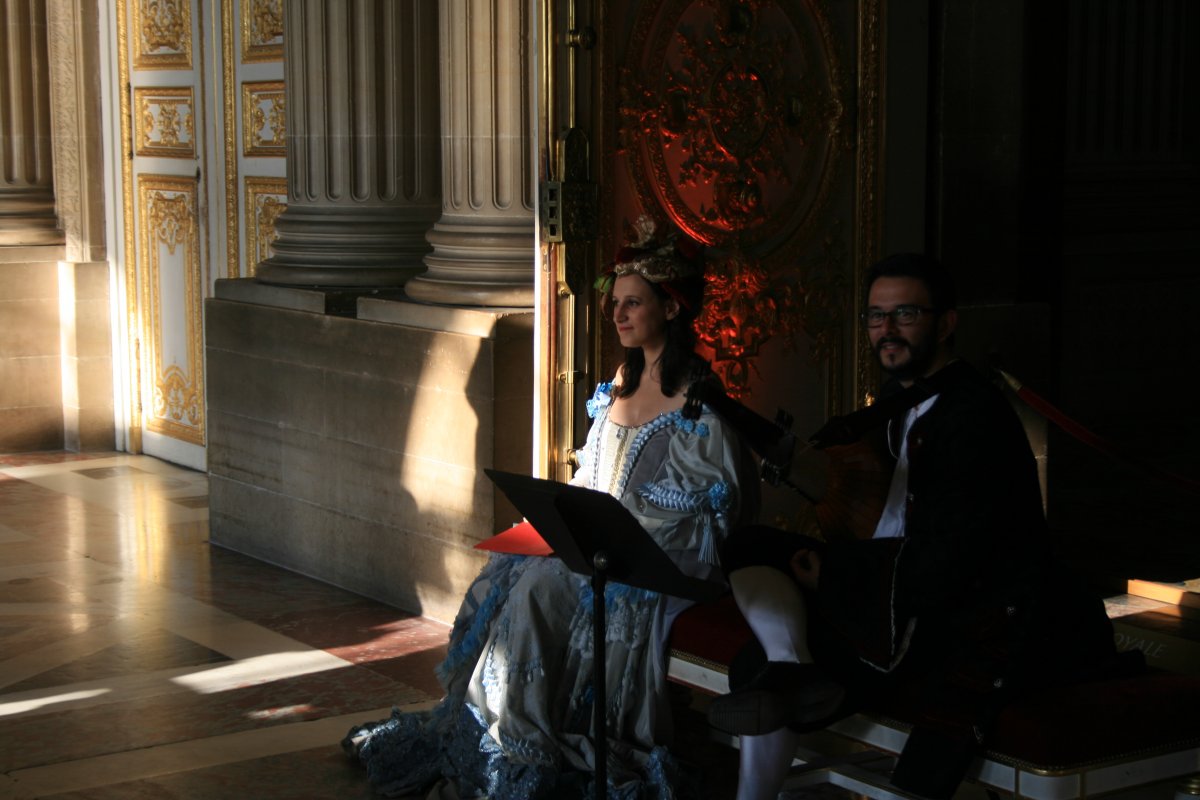 |
|
|
Musician re-enactors in the Hall of Mirrors. As Ira Caro said "I could almost believe I was back in the 17th century and watching a performance presented for the Sun King."
Later there was a fountain night show with fireworks but we were tired and had seen enough so we passed on that.
Versailles is huge, beyond comphrehension, as it was probably intended. You can't take it all in on one visit. Because we arrived in the afternoon, we were not able to do the guided tour of the Private Apartment of the Kings. Next time we will do that for sure. I would probably sign up for an English guided tour as well.
We did not have time, or the strength, to walk to the end of the gardens to see the Trianon Palaces and Domaine de Marie-Antoinette.
Another place I would have liked to have seen but I don't know if it is even possible: the Museum of the History of France where the Gallery of Battles is still as it was. I believe there is another set of rooms on the first floor has been made into galleries on Louis XIV and his court, displaying furniture, paintings, and sculpture.
So we did not see quite a bit: the State Apartments, the King's Wing, the Queen's Wing, the Opera House, the Gallery of Battles, the Trianon Palaces and Domaine de Marie-Antoinette. We definately need to come back someday.
Versaille may be crowded and touristy but it is a must-see on any visit to Northern France.
|
| |
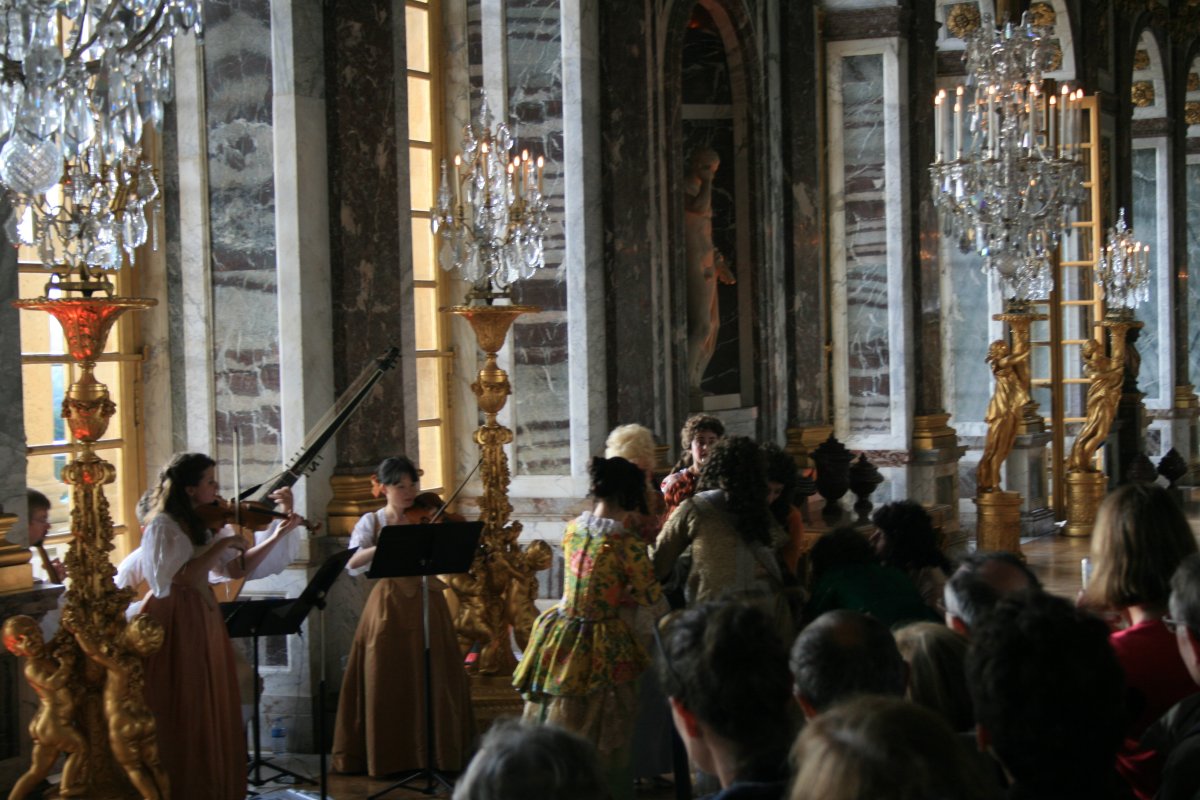 |
|
| |
| |
|
|
|
|
|
|



































